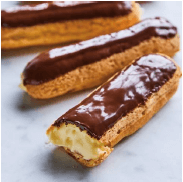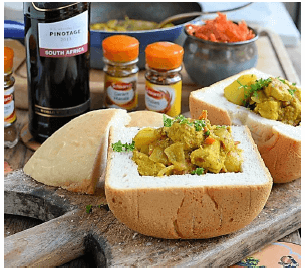Adele
Information Technology Paper 1 Questions - Grade 12 September 2021 Preparatory Exams
INSTRUCTIONS AND INFORMATION
- This question paper is divided into FOUR sections. Candidates must answer ALL the questions in ALL FOUR sections.
- The duration of this examination is three hours. Because of the nature of this examination it is important to note that you will not be permitted to leave the examination room before the end of the examination session.
- This question paper is set with programming terms that are specific to Delphi programming language.
- Make sure that you answer the questions according to the specifications that are given in each question. Marks will be awarded according to the set requirements.
- Answer only what is asked in each question. For example, if the question does not ask for data validation, then no marks will be awarded for data validation.
- Your programs must be coded in such a way that they will work with any data and not just the sample data supplied or any data extracts that appear in the question paper.
- Routines, such as locate, search, sort and selection, must be developed from first principles. You may NOT use the built-in features of Delphi for any of these routines.
- All data structures must be defined by you, the programmer, unless the data structures are supplied.
- You must save your work regularly on the disk/CD/DVD/flash disk you have been given, or on the disk space allocated to you for this examination session.
- Make sure that your name appears as a comment in every program that you code, as well as on every event indicated.
- If required, print the programming code of all the programs/classes that you completed. You will be given half an hour printing time after the examination session.
- At the end of this examination session you must hand in a disk/CD/DVD/ flash disk with all your work saved on it OR you must make sure that all your work has been saved on the disk space allocated to you for this examination session. Make sure that all files can be read.
- The files that you need to complete this question paper have been given to you on the disk/CD/DVD/flash disk or on the disk space allocated to you. The files are provided in the form of password-protected executable files.
Do the following:- Double click on the password-protected executable file.
- Click on the extract button.
- Enter the following password: gR12#21sEpt
Once extracted, the following list of files will be available in the folder
DataSept2021:
Question 1:
- Question1_u.pas
- Question1_u.dfm
- Question1_p.dpr
- Question1_p.res rain.jpg
Question 2:
- dbConnection_u.pas
- Birds.mdb
- BirdsBackup.mdb
- Question2_u.pas
- Question2_u.dfm
- Question2_p.dpr
- Question2_p.res
Question 3:
- Question3ClassDefinition.pas
- Question3_u.pas
- Question3_u.dfm
- Question3_p.dpr
- Question3_p.res
Question 4:
- water.txt
- Question4_u.pas
- Question4_u.dfm
- Question4_p.dpr
- Question4_p.res
QUESTIONS
QUESTION 1: GENERAL PROGRAMMING SKILLS
Do the following:
- Open the incomplete program in the Question 1 folder.
- Enter your full name as a comment in the first line of the Question1_u.pas file.
- Compile and execute the program. The program has no functionality currently.
- Follow the instructions below to complete the code for each section of QUESTION 1, as described in QUESTION 1.1, QUESTION 1.2, QUESTION 1.3 and QUESTION 1.4.
Your school has created a club to provide information and conduct research on water supply and rainfall issues. Complete the program for the club by using the instructions below.
1.1 Button [1.1 Display]
Write code to do the following:
Load the image named rain.jpg into the image component named imgRain.
Enable the panel named pnlBath.
Change the background colour of the panel, named pnlRain, to aqua. (3)
1.2 Button [1.2 Process]
Rainfall calculator.
How many 150 litre baths can be filled after rainfall has occurred over a certain area in your garden or on your roof?
Write code to do the following:
The user will enter the height and width in the spinedits named sedWidth and sedHeight and choose the number of millimetres from the combobox named cmbRain.
The number of 150 litre baths will be equal to the number of square meters multiplied by the amount of water in millimetres and divided by 150. Round the answer to 1 decimal place.
Example: An area of 20 m by 35 m receives 1/2 millimetre (0.5 mm) of rain.
20 x 35 x 0.5 /150 = 2.3 baths (150 litres each)
Use the following data to test your solution:
Rainfall in mm | Height in Metres | Width in Metres | Number of 150 litre baths |
15 | 9 | 10 | 9 |
1/10 | 20 | 20 | 0.3 |
1/2 | 20 | 35 | 2.3 |
30 | 9 | 12 | 22 |
Example of output:
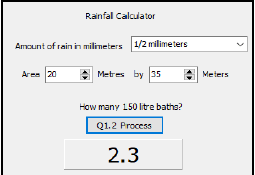 (11)
(11)
1.3 Button [1.3 Find rainfall type]
We wish to find out what type of rainfall occurred in our area.
The following descriptions apply for different amounts of rain that falls in 1 hour.
No rain: Less than 1 mm per hour
Moderate rain: Greater than or equal to 1 mm per hour, but less than 4 mm per hour.
Heavy rain: Greater than or equal to 4 mm per hour, but less than 8 mm per hour.
Very heavy rain: Greater than or equal to 8 mm per hour but less than 10 mm per hour.
Heavy shower: Greater than or equal to 10 mm per hour, but less than or equal to 50 mm per hour.
Flood: Greater than 50 mm per hour.
Write code in this button onclick event to determine the type of rainfall that occurred. The user will enter the amount of rain in millimetres per hour in the edit box named edtRain and then the program must calculate and display, in the label named lblRainfallType, the description of the type of rainfall as described above.
You must also write code to test if an integer has been entered into the edit box named edtRain. If the input is not an integer an error message must be displayed, and the procedure must exit.
Examples of output:
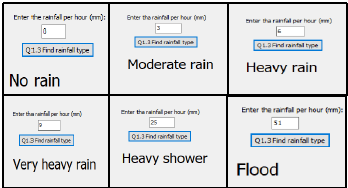 (13)
(13)
1.4 Button [1.4 Display Rainfall]
You are required to calculate and display how many times either 5 mm or 10 mm of rainfall was recorded in 8 different areas.
Write code to repeat the following instructions 8 times:
- Generate 2 different random numbers between 5 and 10 (both included).
- If the random numbers are either 5 or 10, then add 1 to the quantity in the list box named LstQuantity on the correct line that matches the position of either 5 mm or 10 mm as indicated in the list box named LstRain.
- Calculate the sum of the two quantities and display it on the third line of the list box named LstQuantity.
For example: 1 + 2 = 3 and 15 + 10 = 25 - Change the heights of the shapes named shp5mm and shp10mm by adding the values of the corresponding numbers in LstQuantity to the current height of each shape.
Example of output after 1 execution of the button onclick event showing that 1 area experienced 5 mm of rainfall and 2 areas experienced 10 mm of rainfall: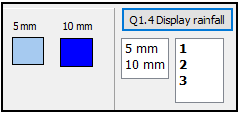
Example of output after more than one execution of the button onclick event: (13)
(13)
- Enter your name and surname as a comment in the first line of the program file.
- Save your program.
- A printout of the code may be required.
[40]
QUESTION 2: DATABASE PROGRAMMING
The database Birds.mdb contains the details of birds and the status of birds in South Africa. The database contains two tables, namely Bird and Status.
Table: Status
This table contains the descriptions of the possible status of a bird.
Field name | Data type | Description |
StatusID | Number | A unique number assigned to each status |
StatusName | Text (50) | The description of the Status of a bird |
Example of data in the Status table: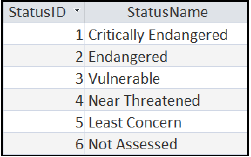
Table: Bird
This table contains information of birds and their sightings in South Africa.
Field name | Data type | Description |
BirdID | Number | A unique number assigned to a bird |
Birdname | Text (50) | The common name of a bird |
Vagrant | Yes/No | Bird wanders beyond the limits of their natural range — can turn up almost anywhere |
Sightings | Number | Total number of sightings of a bird |
Lastsighted | Date (short date) | Date that the bird was last seen |
StatusID | Number | Foreign key to connect to the Bird table |
Example of data of the first fourteen records of the Bird table: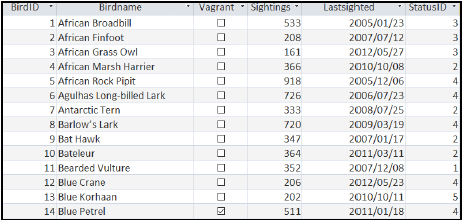
The relationship between the two tables is shown below: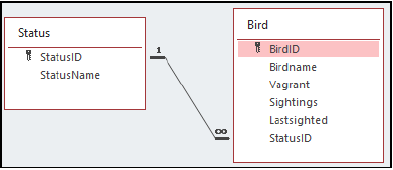
Do the following:
- Open the incomplete project file called Question2_p.dpr in the Question 2 folder.
- Enter your name as a comment in the first line of the Question2_u.pas unit file.
- Compile and execute the program. The program has no functionality currently.
The user interface is displayed below: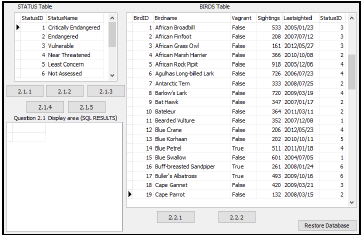
- Follow instructions to complete the code for each question, as described in QUESTION 2.1 and QUESTION 2.2.
- Use SQL code to answer QUESTION 2.1 and Delphi code to answer QUESTION 2.2.
NOTE:
- The [Restore Database] button is provided to restore your data contained in the database to the original content. If you need to test your code on the original data, you may click this button to restore data.
- Do NOT change any of the code provided.
- Code is provided to link the GUI components to the database.
- TWO variables are declared as global variables, as described in the table below.
- Use tblStatus and tblBird components in Question 2.2 only.
| Variable | Data type | Description |
| tblStatus | TADOTable | Refers to the table named Status |
| tblBird | TADOTable | Refers to the table named Bird |
2.1 In this section you may ONLY use SQL statements to answer QUESTION
2.1.1 to QUESTION 2.1.5.
Code to execute the SQL statements and display the results of the queries is provided. The SQL statements are incomplete.
Do the following to complete the incomplete SQL statements assigned to the variables sSQL1, sSQL2, sSQL3, sSQL4 and sSQL5 per question respectively.
2.1.1 Button [2.1.1]
Write SQL code to display all Status details sorted in reverse alphabetical order of StatusName.
Example of output: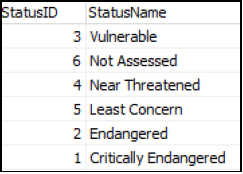 (3)
(3)
2.1.2 Button [2.1.2]
Write SQL code to display the BirdName of all birds that have had less than 200 Sightings.
Example of output: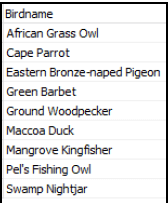 (3)
(3)
2.1.3 Button [2.1.3]
The user must enter the name of a bird. Code has been provided for the bird name “vulture” to be entered in an input box and saved in a variable named sline.
Write SQL code to display the BirdName and LastSighted date of all birds that contain the word stored in the variable, sline.
Example of output: (4)
(4)
2.1.4 Button [2.1.4]
Write an SQL code to delete all birds that have not been assessed and where the status is listed as ‘Least concern’. The StatusID for ‘Not Assessed’ is the number 6 and the StatusID for ‘Least Concern’ is the number 5.
(Code has been written to display the successfully updated table after deleting.)
Example of output of the first 9 records: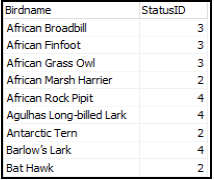 (4)
(4)
2.1.5 Button [2.1.5]
Write SQL code to display the StatusName and BirdName of all birds.
Example of output of the first 8 records: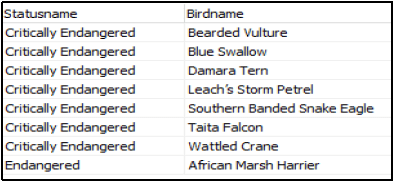 (3)
(3)
2.1.6 Button [2.1.6]
Write SQL code to display the average quantity for each StatusI birds that were LastSighted in the year 2007 using the descr ‘AverageSightings’. The average must be rounded to 2 decimal p D of all iption laces.
Example of output: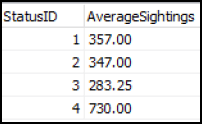 (8)
(8)
2.2 In this section, only Delphi programming code may be used to answer QUESTION 2.2.1 and QUESTION 2.2.2.
Use the global variables, tblStatus and tblBird, provided.
NO marks will be awarded for SQL statements in QUESTION 2.2.
2.2.1 Button [2.2.1]
Write code to display all Birdnames which contain the word ‘EAGLE’ in the richedit named redDisplay.
Example of output: (6)
(6)
2.2.2 Button [2.2.2]
All birds that are categorised as vulnerable must be changed to the status of endangered.
Write code to change the StatusID to 2 of all birds that have a StatusID of 3.
Count how many changes have been made and display the result in the richedit named redDisplay.
Example of output:![]() (9)
(9)
- Enter your name and surname as a comment in the first line of the program file.
- Save your program.
- A printout of the code may be required.
[40]
QUESTION 3: OBJECT-ORIENTED PROGRAMMING
| Birding is defined as a recreational activity by people called birders to identify and observe wild birds in their natural habitat. There are many wild birds that can be sighted by birders in various biological communities in the Eastern Cape. |
Do the following:
- Open the incomplete program in the Question 3 folder.
- Open the incomplete object class Question3ClassDefinition.pas.
- Enter your name as a comment in both Question3ClassDefinition.pas.and Question3_u.pas.
- Compile and execute the program. Currently the program has no functionality.
- Do NOT remove or change any provided code.
The following user interface is displayed: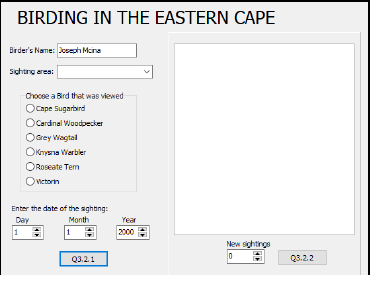
Complete the code for this program, as specified in QUESTION 3.1 and QUESTION 3.2.
3.1 The incomplete class (Tsighting) contains the declaration of five attributes that describe the objBirder object.
NAMES OF ATTRIBUTES | DESCRIPTION |
fName | The name of the person who is a birder |
fArea | The name of the area where the bird was first sighted |
fBird | The name of the bird that was sighted |
fDate | The date that the first sighting of the bird occurred |
fQuantity | The total number of sightings so far |
Complete the code in the object class, as described in QUESTION 3.1.1 to QUESTION 3.1.5 below.
3.1.1 Write code for a constructor method named Create that will receive the name of a birder (person doing the bird watching), area, bird and date of sighting as parameters.
Assign these parameter values to the correct attributes and initialise the attributes for the quantity of birds sighted to ONE. (4)
3.1.2 Write code for a method named getSightings which returns the quantity of bird sightings. (2)
3.1.3 Write code for a method named IncreaseQuantity that will receive one integer parameter to set the quantity of sightings by adding the parameter to the attribute named fQuantity. (4)
3.1.4 Write code for a method name SightingGap which must calculate the number of years that have transpired after the first sighting of a bird took place. Use the current date and the attribute named fDate to return the number of years as a string with the words ‘years since first sighting’ joined to the end of the string.
Example of output: ‘23 years since first sighting.’ (7)
3.1.5 Write code for a method named toString which must return a string.
The string must contain the attributes of the class joined together in the following format:
- <person’s name> first viewed a <bird name>
- <number of years since first sighting> at <area > on <date of first sighting>
Example of output:
- Joseph Mcina first viewed a Cardinal Woodpecker
- 11 years since first sighting at Cape Recife on 4/11/2010 (5)
3.2 An incomplete unit Question3_u.pas has been provided.
It contains code for the object class to be accessible and has a global objec variable, objBirder, already declared.
Do NOT delete or change any provided code. t
Follow the instructions below to code the solution:
3.2.1 Button Q3.2.1
The user will enter a birder’s name, choose a sighting area and bird name and enter the date that the bird was first sighted using the provided input components named edtBirderName, cmbArea, rgpBirds, sedDay, sedMonth and sedYear.
Write code to do the following:
- The date must be concatenated by joining the year, month and date in the format ‘Day/Month/Year’. (Example: 23/9/2012)
- Instantiate the object, objBirder, using the birder’s name, the sighting area, the bird name and the date first sighted.
- Clear the richedit.
Use a method of the class to display the birder’s name, the bir name, the number of years that have passed since first sighting, t area of the sighting and the date of the first sighting.
Example of output: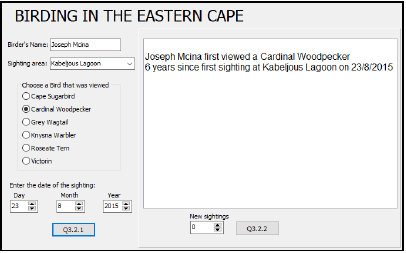 (11)
(11)
3.2.2 Button Q3.2.2
Write code to receive the input from the spinedit named sedSighting.
Use the methods of the class to do the following:
- Increase the quantity of sightings by using the value from the spinedit.
- Display the words ‘Total sightings so far’, as well as the quantity of sightings in the richedit named redDisplay.
Example of output if 3 more sightings was added to the quantity: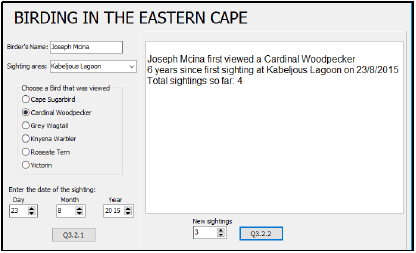 (5)
(5)
- Enter your name and surname as a comment in the first line of the program file. (In both the class and the main program that uses the class)
- Save your programs.
- A printout of the code of both units may be required.
[38]
QUESTION 4: PROBLEM-SOLVING PROGRAMMING
Technically, there is no beginning point of the water cycle, but when asked ‘Where does the water cycle start?’, people have different answers. A survey was conducted with many people who answered this question. You will use the data from this survey to perform calculations and display the answers.
Do the following:
- Open the incomplete program in the Question 4 folder.
- Enter your name and surname as a comment in the first line of the Question4_u.pas file.
- Compile and execute the program. Currently the program has no functionality.
Example of the text file named water.txt: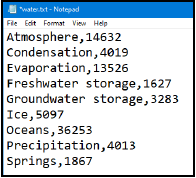
Complete the code for each question, QUESTION 4.1 and QUESTION 4.2.
NOTE:
- Good programming techniques must be applied in the design and coding of your solution.
- You may NOT change the code provided.
Given:
A global array named arrTypes has been declared.
A global array named arrQty has been declared.
A global array counter name iCount has been declared.
A global totalling variable name iSum has been declared.
4.1 Button Q4.1
Write code to do the following:
- Read lines from the text file named water.txt into the two arrays arrTypes and arrQty by separating the type of method and adding it to arrTypes and the number of people who chose that method into the array, arrQty.
- Calculate the total number of people who made a choice and store that into the global variable named iSum.
- Sort the two arrays according to the numbers from low to high in arrQty.
- Display both arrays in redDisplay into neat columns and display the total number of people who took part.
Example of output: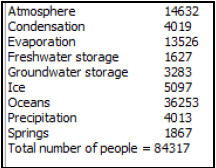 (19)
(19)
4.2 Button Q4.2
Write code to calculate the percentage of each quantity in arrQty using the global variable iSum. Round the answer to no decimal places.
Example: percentage = quantity for a type chosen / sum of all choices x 100 Display the percentages as a symbol for each of four categories.
The FOUR categories consist of the following:
- Percentages between and equal to 1 and 5.
- Percentages between and equal to 6 and 10.
- Percentages between and equal to 11 and 20.
- Percentages between and equal to 21 and 50.
Display a symbol (x) in a neat grid to display the range of percentages for each type from arrTypes.
Example of output: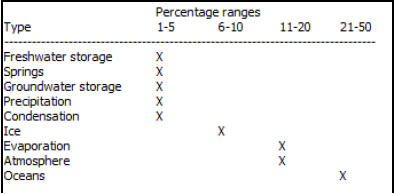 (13)
(13)
- Enter your name and surname as a comment in the first line of the program file.
- Save your program.
- A printout of the code may be required.
[32]
TOTAL: 150
Hospitality Studies Memorandum - Grade 12 September 2021 Preparatory Exams
MEMORANDUM
SECTION A
QUESTION 1
1.1 MULTIPLE-CHOICE ITEMS
1.1.1 B
1.1.2 D
1.1.3 A
1.1.4 C
1.1.5 C
1.1.6 A
1.1.7 B
1.1.8 A
1.1.9 D
1.1.10 B (10 x 1) (10)
1.2 MATCHING ITEMS
1.2.1 G
1.2.2 E
1.2.3 B
1.2.4 A
1.2.5 C (5 x 1) (5)
1.3 MATCHING ITEMS
1.3.1 G
1.3.2 D
1.3.3 B
1.3.4 F
1.3.5 C (5 x 1) (5)
1.4 ONE-WORD ITEMS
1.4.1 Phyllo
1.4.2 Paris Brest
1.4.3 Rosé
1.4.4 Back of House
1.4.5 Sommelier
1.4.6 Ganache
1.4.7 Chutney
1.4.8 Barding
1.4.9 Ficin
1.4.10 Mirepoix (10 x 1) (10)
1.5 SELECTION
1.5.1
- A
C
D
E
G (Any order) (5 x 1) (5)
1.5.2
- B
C
E
F
G (Any order) (5 (5)
TOTAL SECTION A: 40
SECTION B: KITCHEN AND RESTAURANT OPERATIONS; HYGIENE, SAFETY AND SECURITY
QUESTION 2
2.1
2.1.1 Tuberculosis/ TB (1)
2.1.2
- Fever / chills / night sweats
- Coughing blood
- Loss of appetite
- Constant tiredness/ feeling tired all the time
- Chest pain
- Shortness of breath (Any 3) (3)
NOTE: Constant coughing and loss of weight is already mentioned in the scenario.
2.1.3 Joslyn …
- must be put on sick leave.
- must receive treatment for TB.
- can only return to work 7 days after the onset of effective treatment. (Any 2) (2)
2.2
- There will be a workflow disruption / industry might be closed for a while.
- Less workers will lead to low productivity.
- There will be a need for retraining and hiring of workers.
- It will increase indirect costs related to care and treatment of employees. (4)
2.3
- Only give your best
- Never produce work that you are not proud of
- Going an extra mile
- Be willing to take extra classes
- Read cookery magazines and books/ visit cooking websites/ blogs/ watch TV shows or series about cooking
- Try new trends/ experiment with new flavours or styles of presentation
- Become a member of a professional organisation/ meet with peers to exchange ideas (Any 3) (3)
2.4
- Good service creates satisfied customers
- Satisfied customers are willing to pay
- Clients return/ become loyal customers
- Profitability is enhanced/ more customers increase income and profits
- Customers talk favourably about their experience/ positive word of mouth attract more customers (Any 4) (4)
2.5
- Use a credit card with small limits
- Use a secure connection
- Do business with a reputable organisation
- Use the recommended website
- Do not click on any hyperlink contained within a ‘spam’ email
- Always use a secure web browser
- Look out for the closed padlock icon
- Read the terms and conditions of the supplier’s website
- Use a computer privacy filter (Any 3) (3)
TOTAL SECTION B: 20
SECTION C: NUTRITION AND MENU PLANNING; FOOD COMMODITIES
QUESTION 3
3.1
3.1.1
- A – Starter/ salad with main course
Reason: It is small/ savoury/ contains tomatoes, eggs, small slices of ham - B – Dessert
Reason: It contains sweet fruit and pastry (4)
3.1.2
- A clear/ flavoursome savoury jelly (1)
- Clarified meat, fish or poultry flavoured jelly (1)
3.1.3 Allow the mixture to thicken to the consistency of thick egg white before adding the solid ingredients/ chill the gelatine over an ice water bath until it becomes syrupy before solids are added/ solid ingredients should be free of liquid. (2)
3.1.4
- Boil/ cook the fresh pineapple
Reason:
- Raw pineapple contains a proteolytic enzyme, bromelin
- Bromelin breaks down gelatine (3)
3.1.5
- Try not to insert a knife
- Pull it gently away from the sides with your fingertips
- Use a blow-torch briefly around the outside of a metal mould
- Put a warm cloth around the mould
- Dip the mould in hot water for 1–2 seconds (Any 3) (3)
3.2
3.2.1 Barquettes (1)
3.2.2 Shortcrust pastry / Pâte brisée / Pâte à foncer (1)
3.2.3
-
- Blind bake pastry case before adding filling
- Use less water in the pastry
- Check if oven temperature is not too cold/ preheat the oven
- Bake pastry long enough (Any 2) (2)
-
- Do not over-handle or roll pastry
- Rest pastry for 20–30 minutes before rolling
- Work gently; do not stretch during handling (Any 2) (2)
3.2.4
- Line the tart pan with pastry and finish the edges off neatly
- Dock/ pierce small holes into the raw pastry with a fork
- Line the case with foil, a double layer of greaseproof paper
- Fill it with dry beans/ rice
- Bake the pastry case for 10–15 minutes at 180 °C
- Remove the beans/ rice and lining and bake for a further 5–10 minutes until the pastry is dry and lightly browned (Any 4) (4)
3.3
- Add to vegetable stews or thick soups
- Prepare hummus/ a dip from beans, garlic and lemon juice and serve with vegetables as a dip or use it in pitas or wraps
- Lentil patties can be used for hamburgers
- Vegetarian tacos
- Baked beans on toast for breakfast
- Lentil curry with basmati rice (Any suitable 4) (4)
3.4
3.4.1
- Easy to rehydrate and use in dishes
- Does not take much space/ easy to store/ does not need refrigeration
- Has a long shelf life (Any 2) (2)
3.4.2
- It is cheaper than animal protein
- It helps to stretch meat in different dishes (2)
3.4.3
- It is a good source of protein
- It is low in kilojoules/ it does not contain saturated fat or cholesterol
- It is rich in complex carbohydrates and dietary fibre
- It contains several minerals and vitamin B (Any 2) (2)
3.5
Name of dish | Classification | |
A | Poached Pear in Red Wine | Poaching |
B | Lemon Meringue Pie | Baking |
C | Crêpes Suzette | Shallow Frying |
(6) [40]
QUESTION 4
4.1
4.1.1
- Total cost = cost of ingredients + labour cost + overheads
= R15 000 + R6 500 + R5 000
= R26 500 - Selling price = total /food costs + profit
= R26 500 + R11 000
= R37 500 (4)
4.1.2
- Gross profit = selling price – food cost
= R37 500 – R15 000
= R22 500 - Gross profit % = gross profit / total sales x 100
= R22 500 / R37 500 x 100
= 60 % (4)
4.1.3
- = R37 500/ 150
= R250,00 per person (2)
4.2
4.2.1
- Less space is needed – rather allocate the space of the library to the exhibition
- Guests can mingle/ walk around with their plates of cocktails while enjoying the art and photography
- Hospitality Studies learners can collaborate with the Photography club regarding creativity of dishes
- The menu can appeal to different cultural groups
- Finger foods can be inexpensive yet interesting; it can be more profitable/ more visitors can be attracted
- The duration of a cocktail party is usually quite short (Any 4) (4)
4.2.2 Savoury:
- Pizette
- Blinis with Salmon and Cream Cheese
- Canapés with Biltong
Sweet:
- Chocolate Palmiers
- Mini Milktart (5)
4.3
4.3.1
- Chocolate Eclairs (1)
- Choux pastry (1)
4.3.2
- Prevent steam from evaporation/ prevent over boiling
- Steam is the only raising agent (2)
4.3.3
- Low volume with thick crust
- Greasy and heavy eclairs
Motivation:
- Too low temperature / too little steam was generated during the baking process (3)
4.3.4
- The filling softens the eclairs
- Customers expect the eclairs to be crispy and find the soft eclairs unappetising (2)
4.4
- Lemon Syrup/Limoncello/Lemonade
- Frozen lemon juice
- Lemon marmalade
- Lemon curd
- Lemon sorbet
- Salt preserved lemons
(Any suitable 4) (4)
4.5
4.5.1 T-bone/ T-bone steak/ Loin (1)
4.5.2
- A – sirloin
- B – fillet/ fillet of beef (2)
4.5.3
- Any dry heat cooking methods/ frying/ grilling/ roasting/ baking
Motivation:
- It is a soft meat cut and requires little cooking time (2)
4.5.4
- Not suitable
- The T-bone steak has a high fat content with lots of flavour/ the garlic will spoil the meaty flavour/ the cream of the sauce is too rich
OR - It is suitable
- The garlic and cream complements the meaty flavour if added in moderation (2)
4.5.5 Dry red wine/ Cabernet Sauvignon/ Shiraz/ Merlot (Any 1) (1)
[40]
TOTAL SECTION C: 80
SECTION D: SECTORS AND CAREERS, FOOD AND BEVERAGE SERVICE
QUESTION 5
5.1
5.1.1 Food and Beverage (1)
5.1.2
- Accommodation
- Conferences/ Banqueting (2)
5.1.3
- Turn rooms into flats to let
- Offer room service
- Drive through meals/ takeaways instead of sit-down meals
- Meal deliveries
- Special offers on accommodation
- Update website/ virtual tours on website
- Update marketing strategies/ target local market (Any 3) (3)
5.2
- Keeps track of all income and expenses
- Arranges insurance to cover the loss of valuables and injury to staff
- Prepares financial reports or statements
- Draws up budget
- Prepares cash flow forecasts
- Oversees cashiers and having systems in place for them
- Sets up procedures for purchasing, receiving, stores and requisitioning
- Ensures that stocktaking is done on a regular basis
- Takes care of debt collections
- Pays tax and VAT
- Dealing with queries from guests regarding billing and foreign exchange
- Pays staff salaries
- Controls banking procedures
- Oversees the auditing of hotel funds (Any 3) (3)
5.3
5.3.1 Front office/ Reception (1)
5.3.2
- The front office/ reception is the heart of every accommodation establishment
- It is where the guest makes contact with the establishment when he/she makes a booking/ checks in or settles an account/ handling guest problems
- Enquiries are handled through the front office
- Making a good first impression forms the basis of a satisfactory staying experience (Any 3) (3)
5.4
5.4.1
- Ability to identify business opportunities
- Take calculated risks to achieve success
- Sense of responsibility
- Love of achievement
- Creativity, self-reliance and adaptability
- Future-orientated perspective
- Confidence in achieving success
- Good organising and management skills
- High levels of energy and sense of humour (Any 4) (4)
5.4.2 New entrants into the market
- Many people can do exactly the same as what Pumeza did / Pumeza is going to compete against people who were in the business a long time and might have regular customers
The customer’s bargaining power
- Customers might choose the next-door neighbor because they are cheaper / there are many similar food trucks in Durban that offers the same street food
The bargaining power of suppliers of raw material
- Pumeza may have to bargain with suppliers that she buys the ingredients/ packaging from, especially if she buys in bulk
Substitute products
- Other street food items may be more popular/ cheaper for example hotdogs (Any 3 x 2) (6)
5.4.3
- Attractive, clear and appealing pictures
- Post consistently
- Tell stories with the posts
- Build a strong brand
- Choose the right hashtags
- Create the perfect bio
- Produce interesting content
- Cross promote friends and influencers
- Go live on Instagram
- Engage with your followers and targeted audience (Any 3) (3)
5.4.4
- Attractive and creative appearance of food truck
- Providing delivery service in the neighborhood
- Holding special events to attract customers
- Increasing loyalty rewards for dining when food trucks are most active
- Change menus seasonally
- Park at strategic venues
- Testing new recipes and food niches (Any 2 x 2) (4)
[30]
QUESTION 6
6.1
6.1.1 D (1)
6.1.2 A (1)
6.1.3 B (1)
6.1.4 C (1)
6.2
- Waiter asks guests if they prefer hot or cold milk
- Place coffee cup, saucepan and teaspoon to the right of each customer
- The cup’s handle, should point in the direction of the customer’s right hand
- Place the sugar bowl and sweeteners on the table
- Carry the coffee pot and milk jugs on a tray on the palm of your left hand
- Approach guests from the right-hand side and ask if they prefer hot or cold milk
- Pour the coffee by tilting the coffee pot and pouring it up to 16 mm from the rim of the cup. The coffee pot should not leave the tray
- Add milk in the same manner
- Leave the sugar bowl on the table
- Make sure you offer refills when cups are nearly empty (Any 5) (5)
6.3
6.3.1 Silver service (1)
6.3.2
- Arrange food on a suitable platter
- Hold the platter on the flat part of your left hand
- Lower your left hand which is holding the platter to no more than 5 cm from the edge of the guest’s plate
- Pick up the food item with your right-hand using a serving spoon and fork and transfer it to the guest’s plate
- Move around the table in an anticlockwise sequence to serve each guest
- Remember to serve ladies first
- Do not leave the platter on the table (Any 4) (4)
6.4
6.4.1
- Bath or shower daily
- Use deodorant
- Wear clean clothes and uniform
- Follow the care instructions on clothing labels to maintain the fabric’s best look
- Do not wear overpowering perfume or aftershave
- Males should be clean shaven
- Hair must be clean and out of the face
- Head gear should always be worn when handling food
- Keep fingernails clean and short
- Footwear should be clean and safe
- Avoid excessive jewellery
- Do not smoke in food areas
- Cover open burns and cuts with a waterproof dressing
- Hand should be washed immediately after using the toilet, smoking or dealing with refuse (3)
6.4.2
- Acknowledge guests within 30 seconds of arrival; give the guests the menu within two minutes of their arrival.
- Waiters should be friendly and organised.
- Make eye contact.
- Do not speak too loudly or too softly.
- Deal with difficult customers discreetly and ensure that difficult situations are not obvious to other customers.
- Answer the guests’ enquiries about the food and drink available; take an interest in their orders and make appropriate suggestions regarding menu choices.
- Some customers want to be left alone; others want to be entertained. Be aware of customer’s moods.
- Meet special needs of guests, for example, dietary and religious requirements, child seats, wheelchair access, and a non-smoking area.
- Show that you are genuinely pleased to see customers and serve them properly.
- Apologise if customers have been kept waiting.
- Find out and use the names of the people you serve.
- All customers should be treated equally and with the necessary respect and dignity.
- Show respect and courtesy to people with different cultural practises.
- Remember what regular guests like to order.
- Make suggestions and inform customers of special dishes.
- Call a manager if questions are beyond your scope of authority.
- Make sure that guests never have to wait for the bill and always accept gratuities with thanks.(3)
6.5
6.5.1
- Deal with the situation calmly and professionally
- Explain/ announce the situation to the customers
- Apologise and present a limited menu which does not include any dish or beverage that needs an electrical appliance for the preparation e.g. salads and cold beverages
- Start up the generator if the establishment has one
- Restaurant staff should organise lighting such as candles
- Turn off electrical equipment and unplug it
- Use gas stoves and gas equipment (3)
6.5.2
- Be friendly/ Make sure their glasses are filled/ offer the beverage menu
- Inform guests that they have to wait for a certain time (some dishes on the menu may take longer to prepare on an a la carte menu)
- If there is a crisis in the kitchen, be prepared to offer ‘free’ items e.g. bread rolls or coffee, with the approval of the manager. It costs very little but one can keep the customers happy that way. It will depend on the in-house policy of the restaurant
- Some modern restaurants provide entertainment to keep guests busy, for example games (Any 2) (2)
6.6
6.6.1
- D
- A / B
- C (3)
6.6.2 B / Ciropicariello
- Motivation: It is made in Italy / only sparkling wine made in France is allowed to be called champagne. (2)
[30]
TOTAL SECTION D: 60
GRAND TOTAL: 200
Hospitality Studies Questions - Grade 12 September 2021 Preparatory Exams
INSTRUCTIONS AND INFORMATION
- This question paper consists of FOUR sections.
SECTION A: Short questions (All topics) (40)
SECTION B: Kitchen and restaurant operations; Hygiene, safety and security (20)
SECTION C: Nutrition and menu planning; Food commodities (80)
SECTION D: Sectors and careers; Food and beverage service (60) - Answer ALL the questions in your ANSWER BOOK.
- Number the answers correctly according to the numbering system used in this question paper.
- Write neatly and legibly.
QUESTIONS
SECTION A
QUESTION 1
1.1 MULTIPLE-CHOICE QUESTIONS
Various options are provided as possible answers to the following questions. Choose the correct answer and write only the letter (A–D) next to the question numbers (1.1.1 to 1.1.10) in the ANSWER BOOK, for example 1.1.11 C.
EXAMPLE
1.1.11 A good source of protein is …
- oranges.
- pumpkin.
- meat.
- corn flour.
ANSWER: 1.1.11 C
1.1.1 A dessert that is deep-fried:
- Chocolate soufflé
- Churros
- Crêpes Suzette
- Crème Brûlée (1)
1.1.2 A wine that compliments blue cheese, camembert or brie:
- Sparkling wine
- Liqueur
- Rosé wine
- Port (1)
1.1.3 Prevent overheating in Crème Caramel by ...
- using a bain-marie.
- baking it at 220 °C.
- reducing the sugar content.
- using a double boiler. (1)
1.1.4 Smoked oysters on rye bread is served as a ...
- side dish with a main course.
- friandise at a formal dinner.
- snack at a cocktail party.
- hors d’oevres at a Jewish wedding. (1)
1.1.5 The cutlery illustrated below is used when serving ...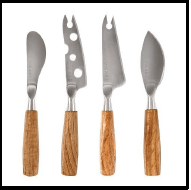
- meat.
- baked pudding.
- cheese.
- fruit. (1)
1.1.6 Suitable table decorations for a meal with an South African ethnic theme:
- Protea flower, cast iron potjie, Shweshwe napkins or table cloth
- Sea shells, blue candles, fish bowl with goldfish
- Red roses, white napkins, silver flowerpots
- Crystal candelabra, mirror squares, tulips in glass vases (1)
1.1.7 For the prevention of gastro-enteritis and possible transmission the following must be done:
- Sanitise work surfaces of food handlers with gastroenteritis
- Food handlers with gastroenteritis should be put on sick leave
- All food handlers must be willing to be vaccinated against gastroenteritis
- Close the kitchen for 10 days when a food handler is diagnosed with gastroenteritis (1)
1.1.8 Lamb noisettes are cut from the:
- Rib and loin
- Neck and thick rib
- Breast and shoulder
- Leg and shank (1)
1.1.9 Choose from the food items illustrated below a good source of protein for vegans: (1)
(1)
1.1.10 The purchasing price of 2,5 kg cake flour is R30. Calculate the cost of the 250 g cake flour.
- R3,33
- R3,00
- R20,83
- R6,00 (1)
1.2 MATCHING ITEMS
Match the example of a food item in COLUMN B that best suits a method of preservation in COLUMN A. Write only the correct letter (A–G) next to the question numbers (1.2.1 to 1.2.5) in your ANSWER BOOK.
COLUMN A | COLUMN B | ||
METHOD OF PRESERVATION | EXAMPLE | ||
1.2.1 | Sun-drying | A | Ketchup (Tomato sauce) |
1.2.2 | Smoking | B | Biltong |
1.2.3 | Additives: salt | C | Milk |
1.2.4 | Additives: sodium benzoate | D | Strawberry jam |
1.2.5 | Pasteurisation | E | Haddock |
F | Canned peaches | ||
G | Tomatoes | ||
(5 x 1) (5)
1.3 MATCHING ITEMS
Choose the food that is excluded from COLUMN B that matches the type of vegetarian in COLUMN A. Write only the correct letter (A–G) next to the question numbers (1.3.1 to 1.3.5) in your ANSWER BOOK, for example
1.3.6 H.
| COLUMN A TYPE OF VEGETARIAN | COLUMN B |
| 1.3.1 Vegan 1.3.2 Lacto-vegetarian 1.3.3 Pesco-vegetarian 1.3.4 Pollo-vegetarian 1.3.5 Fruitarian |
|
(5 x 1) (5)
1.4 ONE-WORD ITEMS
Give ONE word/term for EACH of the following descriptions. Write ONLY the correct word/term next to the question numbers (1.4.1–1.4.10) in the ANSWER BOOK.
1.4.1 A paper-thin pastry used to prepare Greek Baklava
1.4.2 A sweet choux pastry dish where the choux paste is piped in a circle and baked
1.4.3 Natural still wines made from red grapes where the skin is removed after 6 to 24 hours or when the winemaker is happy with the colour
1.4.4 The support areas behind the scenes in a hotel that customers will not see
1.4.5 A trained and knowledgeable wine professional, normally working in fine restaurants, who specialises in all aspects of wine
1.4.6 A glaze, icing, sauce or filling for pastries, made from chocolate and cream
1.4.7 A thick sauce that contains fruits, vinegar, sugar and spices and is used as a condiment with curry dishes
1.4.8 Covering meat with thin slices of bacon or fat
1.4.9 The proteolytic enzyme in fresh figs that prevents setting
1.4.10 Coarsely chopped onions, carrots and celery used for flavouring
(10 x 1) (10)
1.5 SELECTION
1.5.1 Select FIVE principles that must be considered when planning the items of a menu. Write only the letters (A–G) next to the question number (1.5.1) in the ANSWER BOOK.
- Be sensitive to religion and ethical issues
- The profit margin of the institution
- Use a variety of textures; food should not all be crisp or soft
- Do not include too many heavy, starchy items
- Customers on special diets, for example diabetics require specific menus
- The colour scheme and ambience of the restaurant
- Try to include food from all the different food groups (5 x 1) (5)
1.5.2 Select FIVE reasons why service differs from one hotel restaurant to another. Write only the letters (A–G) next to the question number (1.5.2) in the ANSWER BOOK.
- The availability of dishes on the menu
- The level of training differs
- Star grading of hotels
- Customer ratings of the hotel restaurant on websites or social media
- The prices of the dishes is often linked to the level of service
- The type of service offered by the hotel
- The management implements the level of service (5 x 1) (5)
TOTAL SECTION A: 40
SECTION B: KITCHEN AND RESTAURANT OPERATIONS; HYGIENE, SAFETY AND SECURITY
QUESTION 2
2.1 Study the scenario below and answer the questions that follow.
| Stephen, the sous chef at the Karoo Inn, noticed that Joslyn, a young chef, was coughing constantly. It also appeared that Joslyn lost a lot of weight. Stephen advised Joslyn to go for a medical check-up. The doctor confirmed Stephen’s suspicions. |
2.1.1 Predict the disease that Joslyn was diagnosed with. (1)
2.1.2 Name THREE other symptoms, that Joslyn also could have developed. (3)
2.1.3 Recommend TWO preventative measure that the Karoo Inn and Joslyn should have taken to prevent the disease from spreading. (2)
2.2 Critically comment on the negative impact of food-borne diseases on the workforce in the hospitality industry. (4)
2.3 Compose THREE ways how young chefs can develop their commitment to quality and culinary skills. (3)
2.4 List FOUR benefits of good service at a hotel or guest house. (4)
2.5 Recommend THREE safety measures to follow when buying products through the internet/online. (3)
TOTAL SECTION B: 20
SECTION C: NUTRITION AND MENU PLANNING; FOOD COMMODITIES
QUESTION 3
3.1 The two gelatine dishes illustrated below were served at a dinner party with a retro theme. Study the pictures and answer the questions that follow.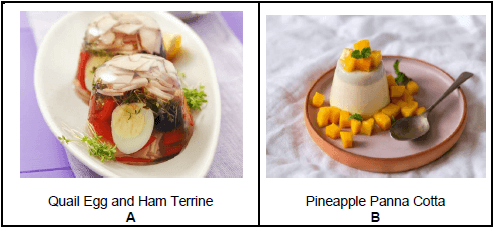
3.1.1 Differentiate between the different courses each of the above dishes will be served during the dinner. Motivate each answer. (4)
3.1.2 Briefly describe the ... of the aspic jelly that was used as the base of dish A.
- qualities (1)
- composition (1)
3.1.3 Both dishes have large quantities of solids distributed evenly through the gelatine mixture. Formulate a technique that the chef used to achieve the even distribution of solids. (2)
3.1.4 Dish B contains fresh pineapple. Advise the chef on the precautionary measures he should follow to have a perfect set fruit mould. Motivate your answer. (3)
3.1.5 Give THREE guidelines to easily unmould the above dishes. (3)
3.2 Study the picture of the pastry dish below and answer the questions that follows.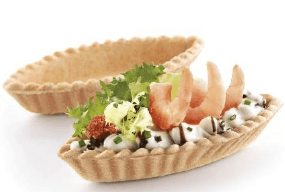
3.2.1 Identify the culinary term for this boat-shaped pastry case. (1)
3.2.2 State the type of pastry used for the dish. (1)
3.2.3 Explain how the following mistakes can be prevented during preparation and baking of pastry dishes:
- Soggy pastry (2)
- Shrunken pastry (2)
3.2.4 Describe step by step how the above pastry cases must be blind baked. (4)
3.3 Compose FOUR different ways how vegetarians can incorporate legumes in dishes for main courses. (4)
3.4 List the advantages of using Textured Vegetable Proteins (TVP) by referring to:
3.4.1 Convenience (2)
3.4.2 Cost (2)
3.4.3 Nutritional value (2)
3.5 Identify and classify the desserts illustrated below according to the cooking methods used.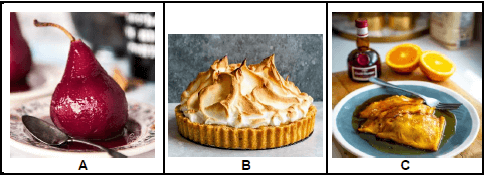
Tabulate your answer as follows:
Name of dish | Classification | |
A | ||
B | ||
C |
(3 x 2) (6)
[40]
QUESTION 4
4.1 Study the information below and answer the questions that follow.
Lemon Tree Wedding Venue | |
Date of function: 16 December 2021 | |
Number of guests: 150 | |
Net profit: R11 000 | |
COSTS | AMOUNT |
Ingredients | R15 000 |
Labour | R 6 500 |
Overheads | R 5 000 |
4.1.1 Calculate the selling price of the event. Show ALL formulas and calculations. (4)
4.1.2 Calculate the gross profit percentage. Show ALL formulas and calculations. (4)
4.1.3 Calculate the cost of the event for each guest. (2)
4.2 The Photography Club of the school hosts an art and photography exhibition in the school library. The Hospitality Studies learners will do the catering for the cocktail snacks for the event.
4.2.1 Motivate the choice of a cocktail party instead of a dinner for the above mentioned event. Give FOUR reasons. (4)
4.2.2 Choose from the list below THREE savoury and TWO sweet food items suitable to be served at the above mentioned event.
| Pizette; Curry and Rice; Malva Pudding with Custard Sauce; Sticky Ribs; Blinis with Salmon and Cream Cheese; Veal Schnitzel; Chocolate Palmiers; Canapés with Biltong; Mini Milktart |
(3 + 2) (5)
4.3 Study the recipe card below and answer the questions that follow.
|
| |
| ||
4.3.1 Identify the:
- Name of the dish (1)
- Pastry used (1)
4.3.2 Explain why one must keep the lid on the saucepan when heating the water and butter in step 1. (2)
4.3.3 Predict the outcome if the chef did not follow the instructions in step 5 and baked the items at 160 °C for 45 minutes. Motivate your answer. (3)
4.3.4 State TWO reasons why the above product has a limited shelf life. (2)
4.4 Recommend FOUR creative ways how chefs can preserve lemons. (4)
4.5 Study the picture of the beef steak below and answer the questions that follow.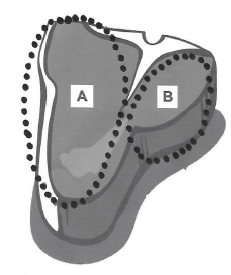
4.5.1 Identify the beef meat cut illustrated. (1)
4.5.2 The meat cut mentioned in QUESTION 4.5.1 can be divided into two smaller portions, illustrated as A and B. Give the name of each portion. (2)
4.5.3 Recommend the best cooking method for the above meat cut. Motivate your answer. (2)
4.5.4 Critically comment on the following: A creamy garlic sauce will complement the flavour of the steak. (2)
4.5.5 Suggest a suitable wine to be served with the steak. (1)
[40]
TOTAL SECTION C: 80
SECTION D: SECTORS AND CAREERS; FOOD AND BEVERAGE SERVICE
QUESTION 5
5.1 Study the extract below and answer the questions that follow.
HOTEL PROFIT LOSSES DURING COVID-19 Covid-19 plunged a knife in the heart of the global hotel industry and destroyed demand, sending revenue and profit to extremely low levels. This global pandemic is the most harmful event to ever hit the hospitality industry. As stridently as room sales have plummeted, the crash in food and beverage (F & B) is even louder. We reviewed data to see how deeply the Food and Beverage department has suffered and what this means for Conference and Banqueting and other areas of the profit-and-loss statement. [Adapted from Hospitality.Net] |
5.1.1 Identify the revenue-generating area that was affected the most by the Covid-19 pandemic. (1)
5.1.2 List TWO more areas that suffered huge profit losses during the global pandemic. (2)
5.1.3 During certain Covid-19 lockdown periods hotels were not allowed to have sit down meals and many accommodation bookings were cancelled. Create THREE innovative solutions for hotels to still earn income from their venue during the Covid-19. (3)
5.2 List THREE responsibilities of an accountant in a hospitality establishment. (3)
5.3 Study the picture below and answer the questions that follow.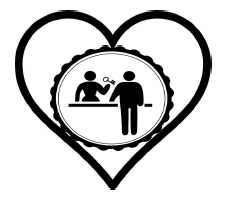
5.3.1 Interpret the information illustrated in the picture and identify the area in the accommodation establishment that is displayed. (1)
5.3.2 State THREE reasons to motivate your answer in QUESTION 5.3.1. (3)
5.4 Study the extract below and answer the questions that follow.
Pumeza is a qualified chef. She lives in Durban. She always dreamed of owning a catering business. She took a leap of faith and decided to start off with pop-up food trucks at different venues in Durban. Her signature dish will be bunny chows, but she will also sell curry and rice, samosas and rotis. She created an Instagram account for her business.
|
5.4.1 Point out FOUR qualities of entrepreneurs that Pumeza needs to have to make a success of her business. (4)
5.4.2 Investigate THREE possible market forces that can have an influence on Pumeza’s business. (3 x 2) (6)
5.4.3 Give THREE guidelines for Pumeza to ensure that her Instagram- account is an effective marketing tool. (3)
5.4.4 Propose TWO innovative ways for Pumeza to gain a competitive advantage in her new business. (2 x 2) (4)
[30]
QUESTION 6
6.1 Choose from the list below the correct equipment needed for the following services and/or procedures during meals. Write down only the letter next to the question numbers (6.1.1–6.1.4), for example 6.1.5 G.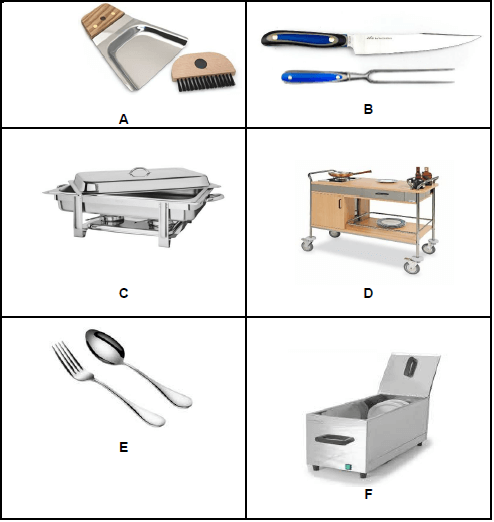
6.1.1 Gueridon service (1)
6.1.2 Crumbing down (1)
6.1.3 Carving meat at buffet (1)
6.1.4 Keeping food hot at buffet (1)
6.2 Briefly explain the correct procedure to follow when serving coffee to guests in a restaurant. (5)
6.3 Study the picture below and answer the questions that follow.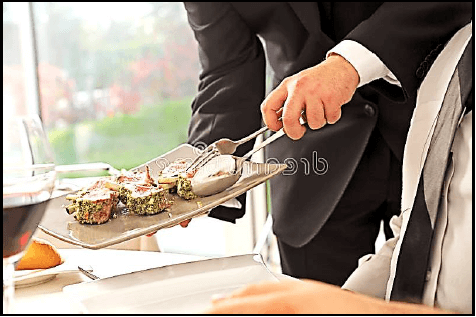
6.3.1 Identify the service style. (1)
6.3.2 Give a brief description of the procedure a waiter must follow when serving food according to the service style mentioned in QUESTION 6.3.1. (4)
6.4 Waiters play an important role in guest satisfaction. They should pay extra attention to their personal hygiene, appearance as well as communication. Compile a list of guidelines for waiters to follow regarding the following:
6.4.1 Appearance and personal hygiene (3)
6.4.2 Communication and dealing with customers (3)
6.5 Formulate guidelines how restaurant staff should handle the following situations during service:
6.5.1 Unexpected power failure (3)
6.5.2 Guests have to wait long for their food (2)
6.6 Study the labels of sparkling wine below and answer the questions that follow.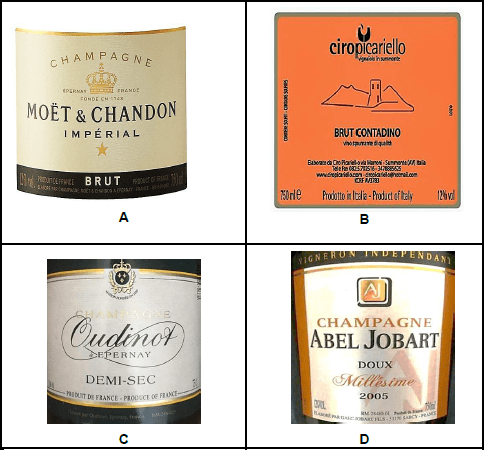
6.6.1 Indicate which of the above sparkling wines will have a ... taste. Write down only the correct letter (A–D).
- sweet
- very dry
- slightly sweet/dry (3)
6.6.2 Identify the wine from the above list of labels that is not allowed to be named champagne. Motivate your answer. (2)
[30]
TOTAL SECTION D: 60
GRAND TOTAL: 200
History Paper 2 Memorandum - Grade 12 September 2021 Preparatory Exams
MEMORANDUM
SECTION A: SOURCE-BASED QUESTIONS
QUESTION 1: WHAT WERE THE CHALLENGES THAT THE SOUTH AFRICAN GOVERNMENT FACED DURING THE 1980s?
1.1
1.1.1 [Definition of a historical concept from Source 1A – L1]
- The government’s response to the ‘Total Onslaught’
- It was to entrench white minority rule at all costs
- Any other relevant response (Any 1 x 2) (2)
1.1.2 [Interpretation of evidence from Source 1A – L2]
- It would reduce international criticism of apartheid
- Satisfy white South Africans
- Form relations with other black countries in Africa
- Reduce internal black resistance
- Any other relevant response (Any 2 x 2) (4)
1.1.3 [Interpretation of evidence from Source 1A – L2]
- To employ black people as community councillors
- This would give them power to run affairs in the townships
- To give black people limited power at local level
- To reduce the demand for political rights and accommodate political aspirations of blacks
- Any other relevant response (Any 1 x 2) (2)
1.1.4 [Extraction of evidence from Source 1A – L1]
- Separate Amenities Act
- Influx control
- Job reservation (Any 2 x 1) (2)
1.2
1.2.1 [Interpretation of evidence from Source 1B – L2]
- The new constitution made provision for the creation of different houses in parliament
- Only Coloureds and Indians were represented with limited powers in the new parliament
- Black South Africans were excluded from the new parliamentary system (seen standing outside the fence)
- The power remained in the hands of the white minority
- Apartheid is being reformed by changing power-sharing
- Any other relevant response (Any 2 x 2) (4)
1.2.2 [Extraction of evidence from Source 1B – L1]
- Coloureds
- Indians (2 x 1) (2)
1.2.3 [Evaluate the limitation of the evidence from Source 1B – L3]
This source is limited because:
- It shows reforms in Parliament only for the three races
- Black people are not considered in the creation of this Parliament
- The source reinforces the idea that whites are enjoying bigger benefits than the other races
- Only the white race is making the decisions
- Any other relevant response (Any 2 x 2) (4)
1.3 [Comparison of evidence from Sources 1A and 1B – L3]
- Source 1A states that the government used a ‘divide and rule’ approach by dividing the population. Source 1B shows the government created a new parliamentary system which created different houses for different races
- Source 1A states that government proposed that political power will be shared amongst whites, coloured and Indians and Source 1B shows the three race groups will be represented in parliament
- Source 1A states that cosmetic changes were implemented by the apartheid government and Source 1B shows that the power is still in the hands of the apartheid government who had the most representatives and the other houses have limited powers
- Any other relevant response (Any 2 x 2) (4)
1.4 1.4.1 [Extraction of evidence from Source 1C – L1]
- Because the opposition became united (1 x 2) (2)
1.4.2 [Extraction of evidence from Source 1C – L1]
- Women
- Students
- Churches
- Trade unions
- Cultural groups
- Sports groups/teams (Any 2 x 1) (2)
1.4.3 [Extraction of evidence from Source 1C – L1]
- Do Not Vote Campaign
- Million Signatures Campaign (2 x 1) (2)
1.4.4 [Interpretation of evidence from Source 1C – L2]
- That all South Africans should have political rights, not only Coloureds and Indians
- That all South Africans should have their rights here in a united, undivided South Africa and not in the homelands
- Their political rights should be given to them immediately
- All races should be treated the same
- Any other relevant response (Any 2 x 2) (4)
1.5
1.5.1 [Extraction of evidence from Source 1D – L1]
- Declining real wages as inflation increased
- Increase in the cost of basic foodstuff and transport
- Overcrowding
- Housing shortage
- Rising rent charges (sometimes by 100%)
- Growing unemployment rate (Any 2 x 1) (2)
1.5.2 [Interpretation of evidence from Source 1D – L2]
- Seen as collaborators with the government
- They were perceived as furthering the aims of apartheid
- Perceived as ‘sell-outs’
- Any other relevant response (Any 2 x 2) (4)
1.5.3 [Definition of historical concepts from Source 1D – L2]
- The police and the army were permanently deployed in the townships
- The police had the power to arrest someone without a warrant
- People could be detained indefinitely
- Lawyers and family were not notified about the arrest
- Censored radio, television and newspapers coverage of these unrests
- Any other relevant response (Any 1 x 2) (2)
1.6 [Interpretation, comprehension and synthesis of evidence from relevant sources – L3]
Candidates could include the following aspects in their response:
- Botha realised the strength of united black resistance (Source 1A)
- The government’s attempts to divide the population was failing (Source 1A)
- Cosmetic reforms implemented with the Tricameral Parliament (Source 1B)
- Limited power given to Coloureds and Indians (Source 1B)
- The opposition to apartheid became united (Source 1C)
- Led to the formation of the UDF that co-ordinated the resistance against apartheid (Source 1C)
- Mass mobilisation against apartheid (own knowledge)
- Marches, strikes and boycotts organised against the government, making the country ungovernable (own knowledge)
- Voter turn-out was low for the election of the new parliament
- Rent boycotts caused the government to lose revenue (Source 1D)
- Government buildings and elements of apartheid destroyed (Source 1D)
- Country in turmoil (own knowledge)
- Any other relevant response
Use the following rubric to allocate marks:
LEVEL 1 |
| MARKS 0–2 |
LEVEL 2 |
| MARKS 3–5 |
LEVEL 3 |
| MARKS 6–8 |
(8) [50]
QUESTION 2: DID THE AMNESTY PROCESS OF THE TRUTH AND RECONCILIATION COMMISSION (TRC) BRING CLOSURE TO THE FAMILY OF NEIL AGGETT?
2.1
2.1.1 [Definition of historical concepts from Source 2A – L1]
- Separateness of races
- Inequalities amongst races
- Any other relevant response (1 x 2) (2)
2.1.2 [Extraction of evidence from Source 2A – L1]
He witnessed:
- Extreme poverty
- Disease affecting black workers
- Overcrowded, poorly resourced hospitals (Any 2 x 1) (2)
2.1.3 [Interpretation of evidence Source 2A – L2]
- When activists were caught committing a political crime by the police it meant detention and death
- There were 50 other activists before Aggett who suffered the same fate
- Many activists died as a result of police brutality
- Any other relevant response (Any 2 x 2) (4)
2.2
2.2.1 [Interpretation of evidence from Source 2D – L2]
- It shows supporters paying tribute to Neil Aggett
- She regards him as a true patriot of this country
- She took to the streets to mourn his death
- She wanted to know the truth of how he died
- Any other relevant response (Any 2 x 2) (4)
2.2.2 [Interpretation of evidence from Source 2D – L2]
- He was a fighter for workers’ rights
- They believed that he died for them
- He died at the hands of the Security Police fighting against the unjust system of apartheid
- Any other relevant response (Any 1 x 2) (2)
2.3
2.3.1 [Definition of a historical concept from Source 2B – L1]
- Official pardon for politically motivated crimes
- Any other relevant response (1 x 2) (2)
2.3.2 [Extraction of evidence from Source 2B – L1]
- Major Cronwright
- Lieutenant Whitehead (2 x 1) (2)
2.3.3 [Interpretation of evidence Source 2B – L2]
- They were seen as communists by the apartheid government
- They were seen as threats that wanted to overthrow the apartheid government
- They instigated labour unrest that destabilised the economy
- Any other relevant response (Any 2 x 2) (4)
2.3.4 [Extraction of evidence from Source 2B – L1]
- Gross violation of human rights (1 x 2) (2)
2.3.5 [Evaluate the reliability of Source 2B – L3]
The source is reliable:
- Some answers to the death of Neil Aggett.
- There were different versions to Agget’s death.
- The interrogators were now telling the truth.
- They were able to find closure
- Any other relevant response (Any 2 x 2) (4)
2.4
2.4.1 [Extraction of evidence from Source 4B – L1]
- Cronwright
- Whitehead (2 x 1) (2)
2.4.2 [Interpretation of evidence Source 2C – L2]
- To find closure
- To find peace
- They wanted to hear the truth of how Neil Aggett died
- Any other relevant response (Any 2 x 2) (4)
2.4.3 [Extraction of evidence from Source 2C – L1]
- The police staged his death
- He committed suicide as a result of the brutal treatment he received (2 x 1) (2)
2.4.4 [Extraction of evidence from Source 2C – L1]
- He could not stop weeping
- He was a broken man (Any 1 x 2) (2)
2.5 [Comparison of evidence from Sources 2C and 2D – L3]
- Source 2C indicates that Neil Aggett’s father mourned his death by weeping. Source 2D shows supporters mourned his death by protesting in the street.
- Source 2C indicates that Neil Aggett had many supporters who wanted his case to be reopened. Source 2D shows one of his supporters placarding in the streets
- Both sources indicated that the family and the supporters were distraught about the death of Neil Aggett
- Any other relevant response (Any 2 x 2) (4)
2.6 [Interpretation, comprehension and synthesis of evidence from relevant sources – L3]
Candidates could include the following aspects in their response:
- The reason for the establishment of the TRC was to deal with the past (own knowledge)
- The TRC offered full amnesty to those who came forward and confessed their crimes (Source 2B)
- TRC provided a platform for the security policemen to reveal the truth about the death of Neil Aggett (Source 2B)
- Smith revealed the truth of how they tortured detainees in his amnesty hearing (Source 2B)
- Victims had the opportunity to confront those who hurt their loved ones (own knowledge)
- Perpetrators were not granted amnesty (own knowledge)
- TRC overruled the decision that Aggett committed suicide (Source 2B)
- Cronwright and Whitehead did not apply for amnesty (Source 2C)
- The TRC was not a court of law that could punish the perpetrators (own knowledge)
- Jill Burger revealed the suffering they endured because of the loss of Neil (Source 2C)
- The family had no closure as they believed he did not commit suicide (Source 2C)
- The two main torturers never appeared before the TRC to reveal the truth on how Neil Aggett died (Source 2C)
- A second inquest was held to reveal the truth on the death of Neil Aggett
- Supporters wanted the perpetrators to be punished (Source 2C)
- Supporters took to the streets to mourn his death (Sources 2C and 2D)
- Any other relevant response.
Use the following rubric to allocate marks:
LEVEL 1 |
| MARKS 0–2 |
LEVEL 2 |
| MARKS 3–5 |
LEVEL 3 |
| MARKS 6–8 |
(8) [50]
QUESTION 3: WHAT IMPACT DID THE GLOBAL COVID-19 PANDEMIC HAVE ON SOUTH AFRICA?
3.1
3.1.1 [Extraction of evidence from Source 3A – L1]
- Wuhan / China (1 x 1) (1)
3.1.2 [Extraction of evidence from Source 3A – L1]
- Partial travel bans
- Travel advisories
- Discouraging public transport
- The closing of schools
- and prohibiting gatherings of more than 100 people (Any 2 x 1) (2)
3.1.3 [Interpretation of evidence from Source 3A – L2]
- Difficult to prevent social distancing
- Spread of the pandemic would be greater
- It affects both staff and learners/students
- Learners/students are travelling by different modes of transport
- Any other relevant response (Any 2 x 2) (4)
3.1.4 [Explanation of a concept from Source 3A – L2]
- A lockdown is a restriction for people or community to stay where they are, usually due to specific risks to themselves or to others if they can move and interact freely. (Any 1 x 2) (2)
3.1.5 [Interpretation of evidence from Source 3A – L2]
- Forced to teach online
- Zoom and Teams teaching
- Rotational teaching
- Any other relevant response (Any 1 x 2) (2)
3.2
3.2.1 [Extraction of evidence from Source 3B – L1]
- Social distancing
- Regular hand washing
- Wearing of masks (Any 2 x 1) (2)
3.2.2 [Interpretation of evidence from Source 3B – L2]
- A state of disaster was declared
- The movement of persons and goods were restricted
- Foreign nationals from high-risk countries were prohibited from entering South Africa
- Limitations on all gatherings
- Any other relevant response (Any 2 x 2) (4)
3.2.3 [Evaluate the usefulness of the evidence from Source 3B – L3]
This source is useful because:
- Their freedom of movement was restricted
- Their freedom of assembly was restricted
- The unemployment rate increased to 1,7 million
- Led to poverty
- Many businesses became bankrupt
- Any other relevant response (Any 2 x 2) (4)
3.2.4 [Extraction of evidence from Source 3B – L1]
- To buy essential goods
- Seek medical attention
- Buy medical products
- Collect social grants
- Attend funerals where no more than 50 people attended (Any 2 x 1) (2)
3.3.
3.3.1 [Extraction of evidence from Source 3C – L1]
- Textiles
- Educational services
- Catering and accommodation
- Beverages
- Tobacco
- Glass products
- Footwear (Any 1 x 1) (1)
3.3.2 [Explanation of historical concepts from Source 3C – L1]
- Fine
- Imprisonment of up to six months (Any 1 x 2) (2)
3.3.3 [Interpretation of evidence Source 3C – L2]
- Due to the decline of activity in the industry, commerce, restaurants and hotels
- Slowdown in economic activities
- Disruption in both the international and domestic supply chain
- South Africa being unable to export its minerals
- Night-time curfews and the ban on the sale of alcohol
- Any other relevant response (Any 2 x 2) (4)
3.4
3.4.1 [Interpretation of evidence Source 3D – L2]
- To help stop the spread of the pandemic (the third wave will be even more devastating)
- To keep taking safety precaution measures to avoid being infected
- Shows the importance of wearing masks at all times
- Any other relevant response (Any 2 x 2) (4)
3.4.2 [Extraction of evidence Source 3D – L1]
- Wear a mask (1 x 2) (2)
3.4.3 [Interpretation of evidence from Source 3D – L2]
- It can cause people to become ill
- It can lead to the death of people
- It could lead to the spreading of the virus
- Any other relevant response (Any 1 x 2) (2)
3.5 [Comparison of evidence from Sources 3B and 3D – L3]
- Source 3B indicates the health measures that must be taken to prevent the spread of the virus. Source 3D shows the measures that must be taken
- Source 3B indicates that certain rights and freedom of South Africans were curtailed. Source 3D shows it is compulsory to wear a mask in public
- Both sources reveal that precautionary measures must be taken to stop the spread of the virus
- Any other relevant response (Any 2 x 2) (4)
3.6 [Interpretation, comprehension and synthesis of evidence from sources – L3]
Candidates could include the following aspects in their response:
- The WHO declared the pandemic as a worldwide issue (Source 3A)
- Forced South Africa to initiate partial lockdown as well as lockdown for schools and higher institutions for 14 days (Source 3A)
- Certain rights and freedom of South Africans were limited (Source 3B)
- It exposed the high rate of poverty in South Africa (own knowledge)
- Limited the freedom of movement and assembly since apartheid (Source 3B)
- Strict lockdown measures imposed in South Africa (Source 3C and 3D)
- Lockdown is not the only solution to the pandemic (Source 3C)
- Social protection programmes should be implemented (Source 3C)
- International funding will eventually come to the rescue (Source 3C)
- Follow the Covid protocols to reduce infection (Source 3D)
- Any other relevant response
Use the following rubric to allocate marks:
LEVEL 1 |
| MARKS 0–2 |
LEVEL 2 |
| MARKS 3–5 |
LEVEL 3 |
| MARKS 6–8 |
(8) [50]
SECTION B: ESSAY QUESTIONS
QUESTION 4: CIVIL RESISTANCE, 1970s TO 1980s: SOUTH AFRICA: THE CRISIS OF APARTHEID IN THE 1980s
[Plan and construct an original argument based on relevant evidence using analytical and interpretative skills.]
SYNOPSIS
Candidates should take a stance on how Steve Biko and the BCM challenged the apartheid regime in the 1970s.
MAIN ASPECTS
Candidates should include the following aspects in their response:
- Introduction: Candidates need to take a stance and demonstrate to what extent Steve Biko and the BCM challenged the apartheid regime in the 1970s.
ELABORATION
- Reason for the formation of the Black Consciousness Movement (Background)
- Biko’s philosophy of Black Consciousness (BC)
- Conscientise black people of the evils of apartheid
- Instilled a sense of self-worth and confidence in black South Africans
- Restore black pride
- Changed the way black South Africans saw themselves
- Empowered them to confront apartheid
- Biko urged black South Africans to assert themselves and to do things for themselves
- Eliminated the feeling of inferiority
- Role of Steve Biko
- Formation of SASO
- SASO spread BC ideas across the campuses of the ethnically separated universities
- SASO promoted black unity and solidarity
- Made students more politically aware
- Encouraged students to liberate themselves from apartheid
- Biko promoted self-liberation
- He believed that association with whites made the liberation struggle ineffective and that blacks must liberate themselves
- Established self-help groups for black communities with other BC leaders
- BC ideas were published in SASO newsletters
- Black Consciousness becomes a national movement
- In 1972 the Black People’s Convention was formed
- Aimed to liberate black people from both psychological and physical oppression
- Self-help projects were set up e.g. Zanempilo Clinic, Ginsburg and Zimele Trust Fund
- Led to the formation of the Black Allied Workers Union in 1973
- BC influenced scholars that led to the formation of SASM
- Challenges posed by the ideas of BC to the state
- At first the South African government was not concerned about the BCM and it seemed in line with its own policy of separate development
- BCM became stronger and posed a challenge to the state
- It became a mass movement that sought to undermine apartheid
- Biko’s speeches encouraged black South Africans to reject apartheid
- BC ideas incited the workers to embark on strike action
- BCM supported disinvestment companies
- Governments reaction to Biko’s philosophy
- Banning and house arrest of Biko and other leaders
- BC leaders were banned from speaking in public
- BPC activists were detained without trial
- SASO was banned on university campuses
- Biko was arrested and interrogated
- Biko was brutally murdered by the security police in 1977
- Any other relevant response
Conclusion: Candidates should tie up their argument with a relevant conclusion. [50]
QUESTION 5: THE COMING OF DEMOCRACY TO SOUTH AFRICA AND COMING TO TERMS WITH THE PAST
[Plan and construct an original argument based on relevant evidence using analytical and interpretative skills]
SYNOPSIS
Candidates should take a stance on whether it was De Klerk’s decision that paved the way for a negotiated settlement that ultimately led to the establishment of a democratic South Africa in 1994.
MAIN ASPECTS
Candidates should include the following aspects in their response:
- Introduction: Candidates need to indicate whether it was only De Klerk’s decision that led to a negotiated settlement that paved the way for a democratic South Africa in 1994.
ELABORATION
- De Klerk comes to power in 1989 – brief background
- De Klerk’s speech in parliament on 2 February 1990 (Political leadership)
- Release of Mandela and the unbanning of political and civic organisations, such as the ANC, PAC and the SACP
- The removal of restrictions on COSATU, AZAPO, etc. (Political leadership and commitment)
- Groote Schuur Minute, 2 May 1990 (ANC and NP met: ANC delegation led by Nelson Mandela, NP delegation led by FW De Klerk) (Political leadership and commitment)
- Apartheid legislation revoked, such as the Separate Reservation of Amenities Act (Political leadership and commitment)
- Pretoria Minute, 6 August 1990 (ANC agreed to suspend the armed struggle)
- CODESA 1 (19 political parties, excluding AZAPO, CP and PAC/300 delegates met) (Political leadership and commitment)
- Violence erupts in some parts of the country, such as the Witwatersrand and Natal
- Whites-only referendum and its impact (March 1992) (Political leadership)
- CODESA 2 (2 May 1992) collapsed. Parties failed to agree on a new constitution making body and interim government (Political leadership and commitment)
- NP wanted minority veto while ANC wanted an interim government for no longer than 18 months and simple majority rule
- Boipatong Massacre and its consequences (17 June 1992)
- Bhisho Massacre derailed the process of negotiations (7 September 1992)
- Record of Understanding signed on 26 September 1992 between Roelf Meyer (NP) and Cyril Ramaphosa (ANC) (Political leadership and commitment)
- Assassination of Chris Hani (10 April 1993) and its impact on South Africa (Political leadership)
- Multiparty Negotiating Forum (Political leadership and commitment)
- Right-wing (AWB) attack on World Trade Centre and its consequences
- Sunset Clause introduced by Joe Slovo broke the negotiations deadlock (Political leadership and commitment)
- Election date announced, 27 April 1994 (Political leadership)
- ANC won elections and Mandela became the first black South African President
- Any other relevant response
Conclusion: Candidates should tie up their argument with a relevant conclusion. [50]
QUESTION 6: THE END OF THE COLD WAR AND A NEW WORLD ORDER: THE EVENTS OF 1989
[Plan and construct an original argument based on relevant evidence using analytical and interpretative skills.]
SYNOPSIS
Candidates need to indicate if they agree with the statement or not. Candidates need to explain if it was the demise of communism that was largely responsible for political changes that occurred in South Africa after 1989.
MAIN ASPECTS
Candidates should include the following aspects in their response:
- Introduction: Candidates need to take a stance and indicate whether the demise of communism was largely responsible for political changes that occurred in South Africa after 1989.
ELABORATION
- Gorbachev’s policies of Glasnost and Perestroika
- By the end of 1989 the Soviet Union disintegrated and its impact
- The communist regimes in Eastern Europa collapsed
- Political changes in the rest of the world put pressure on the apartheid regime to embark on changes
- The collapse of communism affected both the National Party and the ANC
- The National Party was now prepared to negotiate with the ANC
- The National Party’s fear of a communist-controlled ANC now seemed unfounded
- After the demise of communism in the Soviet Union; the ANC did not receive further support from the Soviet Union
- The ANC could no longer rely on the Soviet Union for economic and military support
- The National Party’s claim that it was protecting South Africa from a communist onslaught became unrealistic
- Countries in the western world supported the move that South Africa should resolve its problems peacefully and democratically
- There was no doubt that continued repression of black South Africans by the apartheid regime was not sustainable and would result in political instability
- The government started to believe that reform was needed to include the development of a strong middle-class which would act as a ‘bulwark against the revolution’
- PW Botha suffered a stroke and was succeeded by FW De Klerk
- FW De Klerk realised South Africa’s political predicament and began to accept that the black South African struggle against apartheid was not a conspiracy directed from Moscow
- This enabled De Klerk to engage in discussions with the liberation organisations
- On 2 February 1990 De Klerk announced ‘a new and just constitutional dispensation’
- De Klerk unbanned all anti-apartheid organisations including the ANC, PAC and South African Communist Party
- This signalled the end of apartheid and the beginning of the process of negotiations
- Any other relevant response
Conclusion: Candidates should tie up their argument with a relevant conclusion. [50]
TOTAL: 150
History Paper 2 Addendum - Grade 12 September 2021 Preparatory Exams
ADDENDUM
QUESTION 1: WHAT WERE THE CHALLENGES THAT THE SOUTH AFRICAN GOVERNMENT FACED DURING THE 1980s?
SOURCE 1A
This source below explains why there was increased resistance to apartheid in the 1980s.
After the Soweto Uprising of 1976, the South African government led by P.W. Botha, introduced changes which it claimed were reforms, called the ‘Total Strategy’. Botha also realised the strength of united black resistance. The National Party (NP) government had initially used a ‘divide and rule’ approach by dividing the population into ethnic (Xhosa, Zulu, etc) groups and by treating each other differently. This division was however failing and the resistance against apartheid becoming more and more united. The government therefore tried to find new ways of dividing the population. Its strategy was to admit a small and carefully chosen and controlled number of black people into the middle class. The thinking was that, by creating a richer, black middle class, who would support apartheid and the government because they now needed apartheid to keep their elevated (higher) positions, black resistance would be reduced. In 1982 P.W. Botha’s government passed the Urban Bantu Authorities Act which was an attempt to give more power to black local councillors in the townships. The government also tried to make the gap between Coloured, Indian and African more defined. This was done through the new constitution that the NP introduced in 1983. The constitution created a new parliamentary system, called the Tricameral Parliament. Botha’s government suggested that political power in South Africa be shared among Whites, Coloureds and Indians, with separate houses of parliament to be established for each racial group. The new constitution came into force in 1984, comprising of one hundred and seventy-eight (178) members (all white) House of Assembly, an eighty-five [From www.sahistory.org.za>article>apartheid-era-1980s. Accessed on 12 February 2021.] |
SOURCE 1B
This cartoon below depicts the creation of the Tri-cameral Parliament by the new constitution of 1983.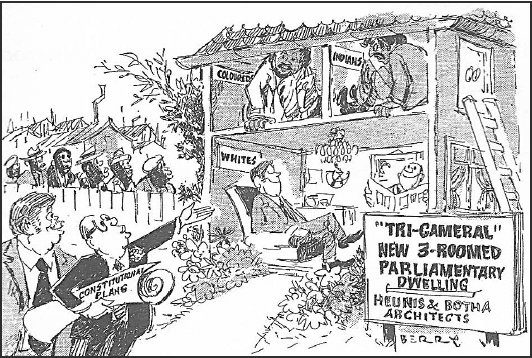
[From sahistory.org.za. Accessed on 12 February 2021].
SOURCE 1C
This source below describes the reaction of the United Democratic Front (UDF) towards the reforms implemented by the apartheid government in the 1980s.
One of the reasons why the 1980s became so violent and moved South Africa towards change was because the opposition to apartheid became united. There was mass action from the people, and although they were all part of different community groups, they acted together for the same aim. A very important organisation during the 1980s was the United Democratic Front (UDF). It was established in response to a call by Dr Allan Boesak at a meeting of the Transvaal Anti-South African Indian Council’s Congress. He suggested that all opposition to the 1983 constitution should be united, or as he put it, “the politics of refusal needed a united front.” The UDF was launched nationally at a meeting in Mitchell’s Plain on 20 August 1983. It consisted of hundreds of women, students, churches, trade unions, cultural, sporting and other groups. At the launch Dr Allan Boesak stated in his speech, “We want all our rights, we want it here and we want it now.” In the period from 1983 to 1989 the UDF established itself as one of the most prominent political movements in South Africa with more than 600 affiliated organisations. They decided on a logo and a slogan, ‘UDF Unites, Apartheid Divides.’ The UDF was quite successful in their initial ‘Don’t Vote’ campaign for the Tri- cameral Parliament, and voter turn-out at the elections was very low. In January 1984 it launched the ‘Million Signatures Campaign’ against apartheid. After its formation, the UDF declared it wanted to establish a true democracy in which all South Africans could participate and create a single, non-racial, unfragmented (undivided) South Africa. [From www.globalsecurity.org>world>war>south-africa5.htm. Accessed on 12 February 2021.] |
SOURCE 1D
This source explains the rent boycotts embarked on by civil society in the township of Mamelodi in 1986.
Evidence that political consciousness in the townships had become increasingly combative (aggressive) emerged during 1986 when the rent boycott spread to 54 townships countrywide. This involved about 300 000 households and cost the state at least R40 million per month. The rent boycotts were a response to both economic and political grievances. Economic grievances involved the level and quality of urban subsistence (survival): declining real wages as inflation increased the cost of basic foodstuff and transport by 20%, overcrowding with a national average of 12 people per household, massive housing shortages, rising rent and service charges (sometimes by 100%) and growing unemployment. Political grievances were linked to state failure to give blacks political rights in general and the persistent inadequacy and illegitimacy of the black local authorities in particular. Therefore, residents attacked and burned government buildings and sought to destroy all elements of the apartheid administration. Numerous attacks were made on the homes of black policemen and town councillors. An August 1986 UDF information pamphlet pointed out that rent was not being paid because ‘people are simply unable to afford it. The rent boycott is … part of an attempt to make apartheid unworkable.’ The rent boycott weakens the structures of the government and demonstrates that there can be no taxation without representation. Unlike consumer boycotts, which aimed at pressurising the state through the middle class white commercial interest, rent boycotts challenge the state directly. President Botha activated security legislation to deal with these crises. In mid-1985 he imposed the first in a series of state of emergencies in various troubled parts of South Africa. [From https://markswilling.co.za/wp-content/uploads/2015/10/ UNITED- DEMOCRATIC-FRONT-AND- TOWNSHIP-REVOLT.pdf. Accessed on 12 February 2021.] |
QUESTION 2: DID THE AMNESTY PROCESS OF THE TRUTH AND RECONCILIATION COMMISSION (TRC) BRING CLOSURE TO THE FAMILY OF DR NEIL AGGETT?
SOURCE 2A
The source below explains the role that Dr. Neil Aggett played in the labour movement and the events that led to his death.
Neil Aggett, the first white South African who died in detention during apartheid was born in Kenya. Aggett’s family moved to South Africa in 1964. Aggett became a medical doctor. His internship at the Mthatha General Hospital and in Tembisa, which were located in poor “black areas”, contributed to his social consciousness. He witnessed the extreme poverty and diseases affecting black workers in these overcrowded, poorly resourced hospitals. This would lead to his involvement in the trade union movement, where he became famous for fighting the cause of workers in the African Food and Canning Worker’s Union. Aggett was arrested for his involvement in the labour movement under the Terrorism Act. He was taken to John Vorster Square, where he was repeatedly interrogated, beaten and tortured by the Special Branch officers, which labelled (regarded) him as a communist. On 5 February 1982, Aggett hanged himself with a scarf. Aggett became the 51st person to die in police detention. At least 15 000 attended his funeral, and his death sparked widespread protests and strikes. [From www.news24.com>news24>southafrica>news>explained-who-was-neil-aggett-and-why-he- importantimportant-20200122. Accessed on 4 February 2021.] |
SOURCE 2B
This photograph shows a supporter mourning the death of Neil Aggett that took place on 13 February 1982.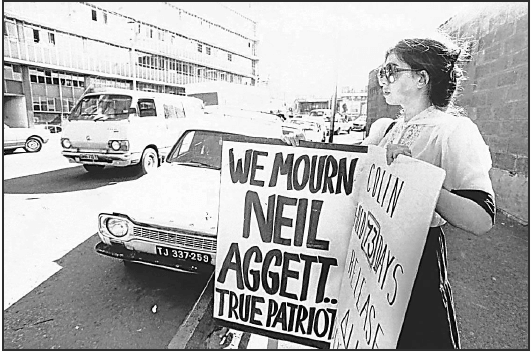
[From https:www.dailymaverick.co.za/article/2021-02-04-remembering-neil-aggett-the-modest-idealist- who-died-for-his-beliefs-39- years-ago. Accessed on 12 July 2021.]
SOURCE 2C
The source below focuses on the reopening of the inquest into the circumstances that led to the murder of Neil Aggett.
Nearly four decades later, the reopening of the inquest into the death in detention of Neil Aggett may finally yield answers and truth. An inquest cleared the apartheid police, security branch officers, of wrongdoing. They called Aggett’s death a suicide. His friends and family have never believed it. Family, friends and a team of supporters, including human rights lawyers, have challenged the National Prosecuting Authority (NPA) since 2003 to have Aggett’s case and those of other activists be reinvestigated. Security Branch policemen, Lieutenant Steven Whitehead and Major Arthur Conwright, who were identified as Aggett’s chief torturers, have died. However, former security branch police officer Nick Deetlefs, who was among the interrogators accused of torturing political activists, was concluding his testimony at the reopened inquest into the death of anti- apartheid activist Dr Neil Aggett. He admitted that he had lied in the previous Aggett inquest, which included concealing his claim that Aggett had said that he did not want to live anymore. Deetlefs accused the security branch of having instructed him to lie about their operations, adding that he had decided that he would tell the truth after legal ‘There is no one that is intimidating (threatening) me now or telling me what to say. My legal representatives told me and warned me that I should tell the truth’. Deetlefs had initially told the court that torture of political detainees was routine practice at the notorious 10th floor of John Vorster Square Police Station, but said he did not know who was responsible for the torture after being asked to name the security officers who assaulted detainees. Aggett’s family representative indicated their intention to pursue criminal prosecution against Deetlefs as they accused him of covering up the torture and murder of Aggett. [From https://www.iol.co.za/news/politics/neil-aggett-inquest-blow-to-deetlefs-credibility-43044277. Accessed on 24 February 2020.] |
SOURCE 2D
The following extract describes an interview by former TRC commissioner, Yasmin Sooka that was held with Jill Burger, Neil Aggett’s sister, at the Johannesburg High Court on 20 January 2020. This was at the second inquest of how his death affected their family.
Many security police, including Cronwright and Whitehead, did not apply for amnesty at the TRC. Therefore, there has been a sustained attempt by activists, the family and the Neil Aggett support group to lobby (push) for the post-apartheid state to pursue Aggett’s torturers. Former TRC commissioner, Yasmin Sooka, says the opening of the inquest marks an important moment for Aggett’s family and many other families to learn about what really happened to those that were brutally tortured by the security police. Sooka said the family is determined to get to the bottom of what happened, but that many former apartheid police officers – some of whom were in command structures – have been regrouping “to prevent any information emerging around things that implicate them”. Jill Burger told the court the family always believed that Neil did not commit suicide, despite a 1982 ruling that cleared the police of any wrongdoing. “He would have never committed suicide. He was a strong man. I believe that the police officers either staged his death, or he committed suicide as a result of the brutal treatment he received. They killed him.” Although Aggett’s socialist views had led to clashes with his less politically aware father, Burger said her father had been distraught about his youngest son’s death. “My father could not stop weeping. He was a broken man,” she told the court. She said her father’s dying wish was that his son’s killers be brought to book. She added that some of her late father’s conservative friends had been under the impression that Neil ‘had got what he deserved’. “My father never spoke to those people again.” “I do still get sad and teary because he was living such a useful life. He had so much more to contribute and we’ve all missed out.” She further continued to say “my wish is that he is at peace and that my mother and father are at peace. My poor loving mother, I’m glad she didn’t live to hear the things that are coming out of the inquest.” [From https:www.dailymaverick.co.za/article/2021-02-04-remembering-neil-aggett-the-modest-idealist-who-died-for-his-beliefs-39-years-ago. Accessed on 4 February 2021.] |
QUESTION 3: WHAT IMPACT DID THE GLOBAL COVID-19 PANDEMIC HAVE ON SOUTH AFRICA?
SOURCE 3A
This source explains the origin of the Covid-19 pandemic and its intended impact on South Africa.
COVID-19 was first identified in the Hubei Province, City of Wuhan, China in the latter part of 2019. Soon after, this disease began to wreak havoc (chaos) and the devastating (harmful) effect of the pandemic forced the World Health Organisation (WHO) to declare it as a global pandemic. In South Africa, the first confirmed case of COVID-19 was recorded on 5 March 2020. The fear of the predicted rate at which the pandemic was to infect people motivated the South African government to declare this pandemic a national state of disaster in terms of the Disaster Management Act. The national state of disaster declared on 15 March 2020 by the President of South Africa Cyril Ramaphosa initially contained partial travel bans, travel advisories, discouraging public transport, the closing of schools, and prohibiting gatherings of more than 100 people. Subsequently, on 23 March 2020, President Ramaphosa instituted a national lockdown that would last for 21 days from 26 March 2020 to 16 April 2020. The lockdown meant that among other organisations that would immediately close were schools and all institutions of higher learning. On 9 April 2020, the President of South Africa announced that the lockdown would be extended by a further 14 days. With the national lockdown, it would mean that the academic calendar for the year 2020 would be affected. To reduce the extent of academic disruptions, several learning institutions responded by moving some of the courses to their online platforms. For basic education, some Non-Governmental Organisations made learning materials available. |
SOURCE 3B
The source below describes the social impact that the COVID-19 pandemic had on South Africa.
COVID-19 has shown its potential devastating (damaging) impact elsewhere, but it is a particular cause for concern in South Africa. While public health strategies such as social distancing, wearing of masks and regular handwashing are encouraged, such strategies are a privilege as many cannot afford it in the overcrowded, informal settlements that is 13% of all households, where many don’t have access to running water. The health systems in high income countries are being stretched, but in South Africa most people rely on the public health system that is under-resourced and is struggling to meet the demands of the pandemic. While the virus does not discriminate on the basis of race, sex or borders, it is likely to affect the poor and those suffering from other comorbidities (multiple illnesses). President Cyril Ramaphosa stated that ‘urgent and drastic’ measures were necessary to limit the spread of the virus. A State of Disaster was declared by the President on 15 March 2020, thereby limiting certain rights and freedoms within South Africa. At the time of the announcements South Africa had the highest number of cases in Africa. The restrictions introduced were the most stringent (strict) in Africa, as South Africa was then the only country on the African continent to require all of its citizens to remain at home. The measures announced on 15 March and 26 March represents the most comprehensive limitations on the freedom of movement and assembly of all South Africa since apartheid. A failure to adhere to these regulations may result in a fine or imprisonment of six months or more. The leaving of a residence is only permitted to buy essential goods, seek medical attention, buy medical products, collect social grants or attend a funeral of no more than 50 people. [From https:/www.sanews.gov.za/south-africa/sa-shares-coronavirus-experiences-bricks. Accessed on 25 January 2021.] |
SOURCE 3C
The source below describes the economic effects that the COVID-19 pandemic had on South Africa.
The economic sectors most disadvantaged include textiles, educational services, catering and accommodation (including tourism), beverages, tobacco, glass products and footwear. As of midnight on 26 March 2020, only essential goods may be sold. This includes any food and animal food products and hygiene products, medical and hospital supplies, fuel, coal, gas and basic goods, including airtime and electricity. The selling of alcohol and cigarettes were prohibited. Price controls on certain goods have also been introduced, including toilet paper, hand sanitiser and some food products. Failure to comply can result in a fine or imprisonment of up to six months. The economy was severely hit as most of the sectors faced a decrease in their productivity due to the lockdown. Workers were laid-off and unemployment rose. The Gross Domestic Product (GDP) fell from 5,1 and up to 7,9 percent in 2020. Given the decrease on household income there will be a decrease in household consumption, which will further fuel the decrease in production. This reduced household income will also lead to increased poverty, especially among the already vulnerable (helpless). [From https://reliefweb.int>reportand covid-19-south-afri-so ca … Accessed on 07 July 2021.] |
SOURCE 3D
This cartoon depicts the Third Covid Wave affecting South Africa and the need to protect South Africans.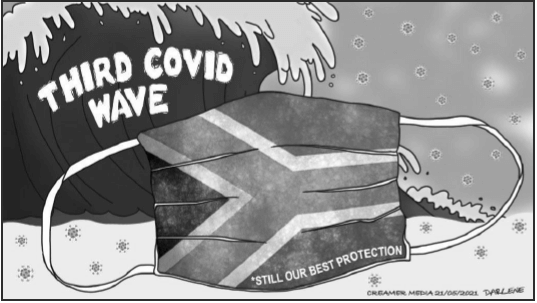
[From Mining Cartoons MiningWiikly.com. Accessed on 8 July 2021.]
ACKNOWLEDGEMENTS
Visual sources and other historical evidence were taken from the following:
- https:www.dailymaverick.co.za/article/2021-02-04-remembering-neil-aggett-the- modest-idealist-who-died-for-his-beliefs-39- years-ago
- http://indianexpress.com/aricle/explained/coronavirus-india/lockdown-migrant- workers-mass-exodus-6348834/
- https://sabctrc.saha.org.za/reports/volume3/chapter6/subsection24.html
- https:/www.sanews.gov.za/south-africa/sa-shares-coronavirus-experiences-bricks
- https://thewire.in/world/bricks-and-covid-rising-powers-in-a-time-of-pandemic
- Mining Cartoons MiningWiikly.com …
- sahistory.org.za
- Times Live 7/2/2021 www.globalsecurity.org>world>war>south-africa5.htm
- www.news24.com>news24>southafrica>news>explained-who-was-neil-aggett-and- why-he-was-important-20200122
- www.sahistory.org.za>article>apartheid-era-1980’s
History Paper 2 Questions - Grade 12 September 2021 Preparatory Exams
INSTRUCTIONS AND INFORMATION
- This question paper consists of SECTION A and SECTION B based on the prescribed content framework in the CAPS document.
SECTION A: SOURCE-BASED QUESTIONS
QUESTION 1: CIVIL RESISTANCE, 1970s TO 1980s: SOUTH AFRICA QUESTION 2: THE COMING OF DEMOCRACY TO SOUTH AFRICA AND
COMING TO TERMS WITH THE PAST
QUESTION 3: THE END OF THE COLD WAR AND A NEW WORLD ORDER, 1989 TO THE PRESENT
SECTION B: ESSAY QUESTIONS
QUESTION 4: CIVIL RESISTANCE, 1970s TO 1980s: SOUTH AFRICA: THE CRISIS OF APARTHEID IN THE 1980s
QUESTION 5: THE COMING OF DEMOCRACY TO SOUTH AFRICA COMING TO TERMS WITH THE PAST: NEGOTIATED SETTLEMENT AND THE GNU
QUESTION 6: THE END OF THE COLD WAR AND A NEW WORLD ORDER: THE EVENTS OF 1989 - SECTION A consists of THREE source-based questions. Source material that is required to answer these questions can be found in the ADDENDUM.
- SECTION B consists of THREE essay questions.
- Answer THREE questions as follows:
4.1 At least ONE must be a source-based question and at least ONE must be an essay question.
4.2 The THIRD question can either be a source-based question or an essay question. - You are advised to spend at least ONE hour per question.
- When answering questions, you should apply your knowledge, skills and insight.
- You will be disadvantaged by merely rewriting the sources as answers.
- Number the answers correctly according to the numbering system used in this question paper.
- Write neatly and legibly.
QUESTIONS
SECTION A: SOURCE-BASED QUESTIONS
Answer at least ONE question, but not more than TWO questions, in this section. Source material to be used to answer these questions is contained in the ADDENDUM.
QUESTION 1: WHAT WERE THE CHALLENGES THAT THE SOUTH AFRICAN GOVERNMENT FACED DURING THE 1980s?
Study Sources 1A, 1B, 1C and 1D and answer the questions that follow.
1.1 Refer to Source 1A.
1.1.1 Define the term Total Strategy in your own words. (1 x 2) (2)
1.1.2 Why, do you think, P.W. Botha introduced these reforms? (2 x 2) (4)
1.1.3 Using the information in the relevant sources and your own knowledge, explain why the apartheid government introduced the Urban Bantu Authorities Act of 1982. (1 x 2) (2)
1.1.4 Quote evidence from the source that suggests that the NP government introduced reforms to Apartheid. (2 x 1) (2)
1.2 Study Source 1B.
1.2.1 What message is conveyed in this cartoon regarding the implementation of the new constitution of 1983? (2 x 2) (4)
1.2.2 Identify the two race groups in the source occupying the upper rooms. (2 x 1) (2)
1.2.3 Comment on the limitations of the information in this source for a historian researching the creation of the Tricameral Parliament. (2 x 2) (4)
1.3 Compare Sources 1A and 1B. Explain how the information in Source 1A supports the evidence in Source 1B regarding the implementation of reforms introduced by the apartheid government. (2 x 2) (4)
1.4 Read Source 1C.
1.4.1 Why, according to the source, was the 1980s violent and moved South Africa towards change? (1 x 2) (2)
1.4.2 Mention any TWO groups in the source that were affiliated to the UDF. (2 x 1) (2)
1.4.3 Name the TWO campaigns in the source that the UDF launched against the apartheid regime. (2 x 1) (2)
1.4.4 Explain what is implied by the words, ‘We want all our rights, we want it here and we want it now’, in the context of Allan Boesak’s speech. (2 x 2) (4)
1.5 Consult Source 1D.
1.5.1 What, according to the source, were the grievances of township dwellers that resulted in rent boycotts? (2 x 1) (2)
1.5.2 Why, do you think, black policemen and councillors were attacked in the townships? (2 x 2) (4)
1.5.3 Explain the term State of Emergency in the context of the reforms introduced by P.W. Botha. (1 x 2) (2)
1.6 Use the information in the relevant sources and your own knowledge, write a paragraph of about EIGHT lines (about 80 words) explaining the challenges that the South African government faced during the 1980s. (8)
[50]
QUESTION 2: DID THE AMNESTY PROCESS OF THE TRUTH AND RECONCILIATION COMMISSION (TRC) BRING CLOSURE TO THE FAMILY OF DR NEIL AGGETT?
Study Sources 2A, 2B, 2C and 2D and answer the questions that follow.
2.1 Study Source 2A.
2.1.1 Define the term apartheid in your own words. (1 x 2) (2)
2.1.2 What, according to the source, did Neil Aggett witness in the hospitals where he worked? (2 x 1) (2)
2.1.3 Explain what is implied by the words, ‘Aggett became the 51st person to die in police detention’, in the context of political detentions. (2 x 2) (4)
2.2 Consult Source 2B.
2.2.1 What messages are conveyed in this photograph? (2 x 2) (4)
2.2.2 Why do you think this supporter is calling Neil Aggett, ‘a True Patriot’? (1 x 2) (2)
2.3 Read Source 2C.
2.3.1 Define the term human rights in the context of the TRC. (1 x 2) (2)
2.3.2 Name the TWO police branch officers in the source that were identified as Aggett’s torturers. (2 x 1) (2)
2.3.3 Why, do you think security branch police officer Nick Deetlefs lied about the death of Neil Aggett? (2 x 2) (4)
2.3.4 How, according to the source, did the family of Aggett respond to Nick Deeflets’ covering up the torture and murder of Dr Neil Aggett? (1 x 2) (2)
2.3.5 Explain the reliability of this source to a historian studying the circumstances leading to Dr Neil Aggett’s death. (2 x 2) (4)
2.4 Use Source 2D.
2.4.1 Name the two security policemen in the source who did not apply for amnesty. (2 x 1) (2)
2.4.2 Comment on the reasons why the activists, family and support groups requested a second inquest into the death of Neil Aggett. (2 x 2) (4)
2.4.3 How, according to Jill Burger, did her brother die? (2 x 1) (2)
2.4.4 Quote a sentence from the source that indicates that Dr Aggett’s father could not accept his death. (1 x 2) (2)
2.5 Compare Sources 2B and 2D. Explain how the information in Source 2B supports the evidence in Source 2D regarding the death of Neil Aggett. (2 x 2) (4)
2.6 Using the information in the relevant sources and your own knowledge, write a paragraph of about EIGHT lines (80 words) explaining whether the amnesty
process of the TRC brought closure to the family of Neil Aggett. (8)
[50]
QUESTION 3: WHAT IMPACT DID THE GLOBAL COVID-19 PANDEMIC HAVE ON SOUTH AFRICA?
Study Sources 3A, 3B, 3C and 3D and answer the questions that follow.
3.1 Read Source 3A.
3.1.1 According to the source, where was COVID-19 first identified? (1 x 1) (1)
3.1.2 Name any TWO restrictions in the source that was announced by President Ramaphosa on 15 March 2020. (2 x 1) (2)
3.1.3 Why, do you think the President took the decision to close schools and institutions of higher education immediately? (2 x 2) (4)
3.1.4 Explain the term lockdown in the context of the COVID-19 pandemic. (1 x 2) (2)
3.1.5 Using the information in the source and your own knowledge, explain how schools were able to complete the academic year. (1 x 2) (2)
3.2 Refer to Source 3B.
3.2.1 List any TWO public health strategies in the source that were encouraged in South Africa during the COVID-19 pandemic. (2 x 1) (2)
3.2.2 Comment on why you think ‘urgent and drastic’ measures were implemented by President Cyril Ramaphosa. (2 x 2) (4)
3.2.3 Explain the usefulness of this source be to a historian studying the consequences of the lockdown regulations on the lives of South Africans. (2 x 2) (4)
3.2.4 When, according to the source, were residents permitted to leave their residences? (2 x 1) (2)
3.3 Consult Source 3C.
3.3.1 Name ONE economic sector from the source that was negatively affected by the Covid-19 pandemic. (1 x 1) (1)
3.3.2 What, according to the source, could happen if a person/company failed to comply with the lockdown regulations? (1 x 2) (2)
3.3.3 Using the information in the source and your own knowledge, explain the reasons why the Gross Domestic Product (GDP) fell drastically in South Africa. (2 x 2) (4)
3.4 Study Source 3D.
3.4.1 What messages are conveyed in this photograph regarding the global Third Wave Covid-19 virus? (2 x 2) (4)
3.4.2 How, according to the photograph, can the spread of the pandemic be prevented? Use visual clues from the photograph. (1 x 2) (2)
3.4.3 Using the information in the relevant sources and your own knowledge, comment on the consequences of the Third Covid-19 virus Wave, if safety precautions were not taken. (1 x 2) (2)
3.5 Refer to Sources 3B and 3D. Explain how the information in Source 3B supports the evidence in Source 3D regarding the measures taken to prevent
the spread of the virus. (2 x 2) (4)
3.6 Using the information in the relevant sources and your own knowledge, write a paragraph of about EIGHT lines (about 80 words) explaining the impact of
global Covid-19 pandemic on South Africa. (8)
[50]
SECTION B: ESSAY QUESTIONS
Answer at least ONE question, but not more than TWO questions, in this section. Your essay should be about THREE pages long.
QUESTION 4: CIVIL RESISTANCE, 1970s TO 1980s: SOUTH AFRICA: THE CRISIS OF APARTHEID IN THE 1980s
‘Steve Biko was viewed as a threat by the apartheid regime.’
Explain to what extent Steve Biko and the Black Consciousness Movement challenged the apartheid regime in the 1970s. [50]
QUESTION 5: THE COMING OF DEMOCRACY TO SOUTH AFRICA AND COMING TO TERMS WITH THE PAST
‘It was De Klerk’s decisions that paved the way for a negotiated settlement that ultimately led to the establishment of a democratic South Africa in 1994’.
Critically discuss the statement. Substantiate your line of argument by using relevant evidence. [50]
QUESTION 6: THE END OF THE COLD WAR AND A NEW WORLD ORDER: THE EVENTS OF 1989
‘It was the demise (downfall) of communism that was largely responsible for political changes that occurred in South Africa after 1989’.
Do you agree with the statement? Substantiate your line of argument by using relevant evidence. [50]
TOTAL: 150
History Paper 1 Memorandum - Grade 12 September 2021 Preparatory Exams
MEMORANDUM
SECTION A: SOURCE-BASED QUESTIONS
QUESTION 1 HOW DID THE BERLIN BLOCKADE CONTRIBUTE TO COLD WAR TENSIONS BETWEEN THE WESTERN POWERS AND THE SOVIET UNION?
1.1
1.1.1 Extraction of evidence from Source 1A – L1]
- Germany (1 x 1) (1)
1.1.2 [Extraction of evidence from Source 1A – L1]
- Germany was divided into four occupational zones
- Berlin was divided as well, with the Western part of the city in Allied hands and the East under Soviet control (2 x 1) (2)
1.1.3 [Extraction of evidence from Source 1A – L1]
- ‘forcing the country to pay war reparations’
- ‘contribute its industrial technology to help post war Soviet recovery’ (Any 1 x 1) (1)
1.1.4 [Interpretation of evidence from Source 1A – L1]
- This is because no agreement had been reached at Yalta or Potsdam on a uniform currency for the different zones.
- The Allies did not inform Russia of the introduction of the new currency, although they jointly controlled Berlin.
- Any other relevant response (Any 1 x 2) (2)
1.1.5 [Extraction of evidence from Source 1A – L2]
- ‘Soviets immediately issued their own currency, the Ostmark, into Berlin and eastern Germany’
- ‘That same day – June 24, 1948 – they blocked all road, railway and canal access to the Allied-occupied zones of Berlin, announcing that the four-way administration of the city had come to an end’ (2 x 1) (2)
1.2 1.2.1 [Definition of a historical concept from Source 1B – L1]
- Cold War is an ideological battle between capitalism and communism without engaging in physical combat.
- Any other relevant response (Any 1 x 2) (2)
1.2.2 [Interpretation of evidence from Source 1B – L2]
- They were avoiding a ‘hot war’.
- They did not want to be perceived as the aggressor.
- Germany had just emerged from a 6-year war, and another war would have caused devastation.
- An armed conflict in Berlin would have led to the deaths of thousands of Germans.
- Any other relevant response (Any 2 x 2) (4)
1.2.3 [Definition of historical concepts from Source 1B – L2]
- Economic system based on private ownership.
- Any other relevant response (Any 1 x 2) (2)
1.2.4 [Extraction of evidence from Source 1B – L1]
- The did not want to risk an armed conflict with the Soviet Union (1 x 1) (1)
1.2.5 Extraction of evidence from Source 1B – L1]
- USA
- Britain
- France (Any 2 x 1)(2)
1.2.6 [Interpretation of evidence from Source 1B – L2]
- To speed up the economic recovery of West Berlin.
- Showing the world that capitalism was better than communism.
- To demonstrate the success of capitalism.
- To prevent possible riots amongst the residents of West Berlin.
- To bring about divisions in East Germany and East Berlin
- To cause divisions amongst communist thinking
- Any other relevant response (Any 1 x 2) (2)
1.3
1.3.1 [Extraction of evidence from Source 1C – L1]
- Food
- Coal
- Clothes
- Other necessities (Any 2 x 1) (2)
1.3.2 [Interpretation of evidence from Source 1C – L2]
- They were cut off from essential necessities.
- Residents were cut off from relatives who lived in the other zones.
- Residents of West Berlin were now exposed to power outages, food shortages and food rationing.
- Residents of West Berlin were adversely hit by the blockade.
- Any other relevant response (Any 1 x 2) (2)
1.3.3 [Interpretation of evidence from Source 1C – L2]
- They wanted to showcase their resistance against the blockade.
- They did not want to give in to communist pressure.
- They wanted to show Russia that they were not dependent on them.
- To demonstrate their determination to live under a capitalist order.
- They would have lost their independence had they accept help from the Russians.
- Any other relevant response (Any 2 x 2) (4)
1.3.4 [Evaluate the usefulness of evidence from Source 1C – L3]
The source is USEFUL because:
- It shows that the Allies did not give in to Russian pressure.
- It gives the finer details of the airlift that the Allies used to provide West Berlin with supplies
- It demonstrates the Allies’ resolve to limit communism.
- It demonstrates the Allies’ determination to protect and support capitalist and democratic countries.
- Any other relevant response (Any 2 x 2) (4)
1.4
1.4.1 [Interpretation of evidence from Source 1D – L3]
- It shows Western powers delivering the necessities in West Berlin.
- They used airplanes to deliver food to West Berlin because of the Blockade.
- Any other relevant response (Any 2 x 2) (4)
1.4.2 [Extraction of evidence from Source 1D – L1]
- Airplanes (1 x 1) (1)
1.5 [Comparison of evidence from Sources 1C and 1D – L3]
- Source 1C states that British and American soldiers made about 400 000 flights into Western Berlin carrying necessities and Source 1D shows soldiers delivering necessities to West Berlin.
- Source 1C states that British and American soldiers delivered nearly two million tons of food, coal, clothing and other essentials while Source 1D clearly depicts the crates in which the food, coal and essentials were transported.
- Both sources show that food were delivered through air lifts
- Any other relevant response (Any 2 x 2) (4)
1.6 [Interpretation, analysis and synthesis of evidence from relevant sources – L3]
Candidates may use the following as points to answer the question:
- The United States, France and Soviet Union divided Germany and Berlin into four zones (Source 1A)
- The Western powers decided to combine their sectors to form West Berlin while Russia named their zone East Berlin (Own knowledge)
- No agreement was reached on a uniform system of government in different zones (Own knowledge)
- Western powers introduced a new currency and it led to prosperity in the West compared to the poverty in East Berlin.
- Stalin perceived the introduction of the new currency as a violation of post war agreements (Source 1A)
- Stalin blocked all the access routes and canals to gain total control Berlin (Source 1A)
- Western allies were not prepared to risk armed conflict with the Soviets as a way to open access routes to West Berlin (Source 1B)
- They decided to supply their sectors with all the necessities through airlifts (Source 1B, 1C and 1D)
- Flights were landing every 45 seconds at one of the three airports in West Berlin (Source 1C and Source 1D)
- Stalin on the other side was not prepared to risk a war by shooting those airplanes (Source 1B)
- In May 1949, Stalin ended/lifted the Blockade (Source 1B)
- Any other relevant response
Use the following rubric to allocate a mark:
LEVEL 1 |
| MARKS 0–2 |
LEVEL 2 |
| MARKS 3–5 |
LEVEL 3 |
| MARKS 6–8 |
(8)
[50]
QUESTION 2: WHY DID ANGOLA BECOME THE FOCAL POINT OF THE COLD WAR IN AFRICA DURING THE 1970s?
2.1
2.1.1 [Extraction of evidence from Source 2A – L1]
- ‘Diamonds’
- ‘Oil’ (2 x 1) (2)
2.2.2 [Definition of a historical concept from Source 2A – L1]
- A peace agreement between fighting parties to bring an end to an armed conflict
- Any relevant response (Any 1 x 2) (2)
2.1.3 [Extraction of evidence from Source 2A – L1]
- ‘Portugal’ (1 x 1) (1)
2.1.4 [Extraction of evidence from Source 2A – L1]
- ‘MPLA’
- ‘FNLA’
- ‘UNITA’ (3 x 1) (3)
2.1.5 [Interpretation of evidence from Source 2A – L2]
- Russia wanted to spread communism in Africa.
- Russia wanted to obtain naval bases in Africa
- Russia wanted to sign trade agreements with African countries
- Any relevant response (Any 2 x 2) (4)
2.2
2.2.1 [Extraction of evidence from Source 2B – L1]
• ‘… the superpowers and their allies delivered military assistance to their preferred clients’ (1 x 2)
(2)
2.2.2 [Interpretation of evidence from Source 2B – L2]
- The USA wanted to prevent the communist MPLA from taking over Angola.
- The USA wanted to safeguard her petroleum interests in Angola.
- The USA did not want to send troops to Angola since she was already defeated in Vietnam; hence they supported these movements to overthrow the MPLA.
- Any other relevant response (Any 1 x 2) (2)
2.2.3 [Interpretation of evidence from Source 2B – L2]
- The MPLA and Castro were communist allies.
- Many Cubans were of Angolan descent.
- Any other relevant response (Any 1 x 2) (2)
2.2.4 [Definition of historical concept in Source 2B – L2]
- The right of Angolan citizens to govern themselves free from colonial rule.
- Any other relevant response (Any 1 x 2) (2)
2.3
2.3.1 [Extraction of evidence from Source 2C – L1]
- ‘Russians’
- ‘Cubans’ (2 x 1) (2)
2.3.2 [Extraction of evidence from Source 2C – L1]
- ‘Ruacana’
- ‘Calueque’ (2 x 1) (2)
2.3.3 [Interpretation of evidence from Source 2C – L2]
- The MPLA was a communist organisation.
- The MPLA was against SA Apartheid policy
- The MPLA allowed SWAPO and ANC to establish military bases in Angola.
- SA did not want to be surrounded by communist neighbouring states.
- Any other relevant response (Any 2 x 2) (4)
2.3.4 Evaluate the usefulness of evidence from Source 2C – L3]
The source is USEFUL because:
- It gives an objective view of SA’s involvement in the Angolan Civil War of 1975
- The purpose of the source is to inform the reader about SA’s reasons for intervening in Angola.
- It highlights the SA government’s fear of communism.
- It shows that SA had economic and political interest in SWA that they wanted to protect.
- Any other relevant response. (Any 2 x 2) (4)
2.4
2.4.1 [Interpretation of evidence from Source 2D – L2]
- SA and UNITA had a very good relationship.
- SA and UNITA were allies.
- SA and UNITA supported each other’s objectives during the Angolan Civil War
- SA favoured or preferred UNITA as the ruling party in Angola.
- Any other relevant response (Any 2 x 2) (4)
2.4.2 [Interpretation of evidence from Source 2D – L2]
- UNITA is the enemy of the MPLA and SA; hence the two are allies.
- UNITA is the enemy of the MPLA and therefore UNITA is a friend of SA.
- Any other relevant response (Any 1 x 2) (2)
2.5 [Comparison of information from Source 2C and Source 2D – L3]
- Source 2C states that SA supported UNITA whilst this support is clearly depicted in Source 2D.
- Source 2C states that SA started to train UNITA soldiers whilst this support is clearly depicted in the photograph where Magnus Malan is seen next to PW Botha and Jonas Savimbi
- Both sources depict SA and UNITA as allies.
- Any other relevant answer (Any 2 x 2) (4)
2.6 [Interpretation, analysis and synthesis of evidence from relevant sources – L3]
Candidates may include the following aspects in their responses.
- After independence, the three movements competed for power in Angola (Own knowledge)
- Angola was rich in diamonds and oil and thus sparked foreign interference (Source 2A)
- The superpowers and their allies delivered military assistance to their preferred clients (Source 2B)
- The foreign powers provided aid to different liberation movements (MPLA, FNLA and UNITA) in Angola (Source 2A and 2B)
- The USA supplied aid and training to FNLA and UNITA (Source 2B)
- The Soviet Union also provided military training and equipment to the MPLA (Source 2B)
- SA supported UNITA because they wanted to prevent the spread of communism in Southern Africa (Source 2B)
- SA wanted to break its own isolation and therefore welcomed the US request to support UNITA (own knowledge)
- MPLA negotiated with Castro for Cuban assistance (Source 2B)
- SA was against the communist MPLA (Source 2C)
- South Africa supported UNITA (Source 2B)
- South Africa had economic interests in SWA – Ruacana and Calueque dams (Source 2C)
- SA supported UNITA as official government of Angola (Source 2C and 2D)
- SA and UNITA united in their effort to topple the MPLA as the official government of Angola. (Source 2C and 2D)
- Any other relevant answer
Use the following rubric to allocate a mark:
LEVEL 1 |
| MARKS 0–2 |
LEVEL 2 |
| MARKS 3–5 |
LEVEL 3 |
| MARKS 6–8 |
(8)
[50]
QUESTION 3: WHAT CHALLENGES DID THE LITTLE ROCK NINE FACE DURING THE INTERGRATION OF CENTRAL HIGH SCHOOL IN 1957?
3.1
3.1.1 [Extraction of information from Source 3A – L1]
- ‘that the racial segregation in educational facilities was unconstitutional’ (1 x 2) (2)
3.1.2 [Definition of historical concept in Source 3A – L1]
- The end of segregation and the opening of facilities to all races.
- Any other relevant response (Any 1 x 2) (2)
3.1.3 [Interpretation of evidence from Source 3A – L2]
- It meant that segregated schools and universities were against the law.
- It meant that segregated educational facilities were not accepted and protected in the constitution.
- Any other relevant response (Any 1 x 2) (2)
3.1.4 [Extraction of evidence from Source 3A – L1]
- ‘Eighty students’ (1 x 1) (1)
3.1.5 [Interpretation of evidence from Source 3A – L2]
- They were more comfortable amongst their own people.
- They wanted to avoid racism towards them at Little Rock.
- They did not want to be humiliated.
- They knew their safety would not be guaranteed.
- They avoided prosecution at the hands of the KKK.
- Any other relevant response (Any 1 x 2) (2)
3.2
3.2.1 [Extraction of evidence from Source 3B – L1]
- ‘All alone, her knees shaking …’ (1 x 2) (2)
3.2.2 [Extraction of evidence from Source 3B – L1]
- ‘A jeering mob blocked her path’
- ‘The mob surrounded her’
- ‘Get a rope’
- ‘Drag her over to this tree!’
- ‘Let’s take care of the nigger’ (Any 3 x 1) (3)
3.2.3 [Interpretation of evidence in Source 3B – L2]
- The white mob was opposed to integration at Central High School
- The white mob was still racist.
- The white mob believed that whites were superior, and blacks were inferior.
- Any other relevant response (Any 2 x 2) (4)
3.2.4 [Interpretation of evidence from Source 3B – L2]
- Grace Lorch was not a racist
- Grace Lorch did not perceive blacks to be inferior.
- Grace Lorch was in favour of integration.
- Grace Lorch saw all races as equal.
- Grace Lorch had sympathy for the plight of Blacks.
- She showed sympathy to Eckford
- Any other relevant response (Any 2 x 2) (4)
3.3
3.3.1 [Interpretation of evidence from Source 3C – L2]
- Racial integration was not tolerated by the white community in Arkansas.
- Racial integration would be very hard to implement.
- Racial integration was even prevented by the state police.
- Any other relevant response (Any 2 x 2) (4)
3.3.2 [Evaluating the reliability of evidence in Source 3C – L3]
The source is RELIABLE to a large extent because:
- It is a primary source providing first-hand information about the event.
- The information can be confirmed by other historical sources.
- The photographer was present during the event – eyewitness
- Any other relevant response (Any 2 x 2) (4)
3.4 [Comparison of evidence in Sources 3B and 3C – L3]
- Source 3B declares that Elizabeth was greeted on her way to school by an angry white crowd, while Source 3C portrays the angry crowd
- Source 3B states that the National guardsmen did nothing to protect Elizabeth while Source 3C portrays the National Guardsmen as passive soldiers who observe the event instead of protecting Elizabeth.
- Any other relevant response (Any 2 x 2) (4)
3.5
3.5.1 [Extraction of evidence from Source 3D – L1]
- ‘… he had taken the action to defend the rule of law’
- ‘and prevent mob rule and anarchy’ (2 x 1) (2)
3.5.2 [Extraction of evidence from Source 3D – L1]
- ‘Black students were subjected to verbal and physical assaults from a faction of white students.’
- ‘Melba Patillo, one of nine, had acid thrown in her eyes.’
- ‘Elizabeth Eckford was pushed down a flight of stairs.’
- ‘The three male students in the group were subjected to more conventional beatings.’
- ‘Minnijean Brown was suspended after dumping a bowl of chili over the head of a taunting white student’ (Any 2 x 1) (2)
3.5.3 [Interpretation of evidence from Source 3D – L2]
- He was against racial integration of schools.
- Faubus was a racist
- Faubus wanted to prevent the Black learners from entering the school
- Any other relevant response (Any 1 x 2) (2)
3.5.4 [Definition of historical concept in Source 3D – L2]
- Refers to the situation where African Americans and whites would share the same facilities without racial discrimination.
- Any other relevant response (Any 1 x 2) (2)
3.6 [Interpretation, analysis and synthesis from relevant sources – L3]
Candidates may include the following aspects in their responses:
- Racial discrimination was very common in the southern states and Arkansas was also affected (Source 3A)
- Brown versus Board of Education of Topeka ruled that racial segregation in educational facilities was unconstitutional (Source 3A
- Integration at Little Rock was approved but because it was located in the south, many challenges were expected (Source 3A)
- Elizabeth Eckford, one of the Little Rock Nine was denied entry at Central High School (Source 3B)
- An angry white mob surrounded, shouted and harassed her (Source 3B)
- The guards did nothing to protect Elizabeth Eckford (Source 3B and 3C)
- The president decided to enforce integration by force (Source 3D)
- Black students were subjected to verbal and physical assaults (Source 3D)
- Governor Faubus fought school integration plan by closing Little Rock’s high school rather than allowing integration (Source 3D)
- Despite challenges, majority of Black students graduated (Source 3D
- Any other relevant response
Use the following rubric to allocate a mark:
LEVEL 1 |
| MARKS 0–2 |
LEVEL 2 |
| MARKS 3–5 |
LEVEL 3 |
| MARKS 6–8 |
(8)
[50]
SECTION B: ESSAY QUESTIONS
QUESTION 4: THE COLD WAR – VIETNAM
[Plan and construct an original argument based on relevant evidence using analytical and interpretative skills.]
SYNOPSIS
Candidates need to agree or disagree with the statement and support their argument with relevant historical evidence. In disagreeing with the statement candidates should identify and discuss the other military strategies that were used to contain communism.
MAIN ASPECTS
Candidates should include the following aspects in their responses:
Introduction: Candidates should agree or disagree with the statement and briefly explain their reasons.
ELABORATION
- After the French Vietnamese war, Vietnam was divided, along the 17th Parallel, into North and South Vietnam
- North Vietnam was under a communist regime, while South Vietnam was under a capitalist regime
- The USA gave unconditional support to South Vietnam.
- South Vietnam was ruled by the corrupt and unpopular Ngo Dinh Diem
- The National Liberation Front was formed and had a guerrilla army, the Vietcong.
- Ngo Dihn Diem was overthrown – instability in South Vietnam
- Vietcong started a protracted campaign to unify Vietnam
- China and North Vietnam supported the Vietcong
- The USA got involved – to prevent the spreading of communism in South East Asia – the ‘Domino Effect’
- The Vietcong received supplies from the communist North Vietnam through the Ho Chi Minh Trail
- USA’s operation Rolling Thunder: Bombing campaigns directed against North Vietnam. Thousands of civilians were killed by the bombs. Bombing was intensive and it lasted for eight years. The operation failed, partly because North Vietnam was mainly a farming country and there were no military or industrial targets. Russia and Chinese were able to replace all military supplies that the Americans destroyed.
- Tet Offensive: On 30th January 1968 the Viet Cong and North Vietnamese Army launched widespread attacks on about 100 cities and towns. These attacks were timed to coincide with the first day of the Tet holiday although there was an agreement to observe a ceasefire during the holiday. The attack came as a surprise to the South and its American allies.
- The USA’s use of technological weapons: Americans used some methods that relied on the application of science to warfare. Helicopters were used to transport troops. A great problem for the Americans was finding the VC in the thick, tropical jungle. They therefore developed ‘Agent Orange’ to destroy the bush where the VC soldiers could hide. ‘Agent Blue’ was used by Americans and it polluted the land, which remained infertile for many years. America also used chemicals that caught fire. Napalm produces a thick gel that attaches itself to the skin and burns through to the muscle and bone.
- Search and destroy policy: The purpose of the policy was to find the enemy and destroy him. One problem was identifying the enemy. Innocent civilians were the victims of the bombs. So it was very much a hit-and-miss policy.
- The USA’s public opposition to the war
- The USA’s heavy losses
- The USA’s withdrawal
- Fall of Saigon: The capital of South Vietnam was Saigon and the American embassy itself was seized by guerrillas after six and half hours. Americans watched this event on TV. The symbol of American power and prestige that dominated downtown Saigon has been disposed of with bullet holes.
- American perspective of the war
- Vietnamese perspective of the war
- Any other relevant response.
- Conclusion: Candidates should tie up their argument with a relevant conclusion. [50]
QUESTION 5: INDEPENDENT AFRICA: CASE STUDY – THE CONGO
[Plan and construct an original argument based on relevant evidence using analytical and interpretative skills.]
SYNOPSIS
Candidates must focus on the political and economic challenges that the Congo faced after attaining independence. They should also emphasise all the successes that have been achieved despite the circumstances.
MAIN ASPECTS
Candidates should include the following aspects in their responses:
Introduction: Candidates should critically discuss the successes and challenges faced by Congo with specific reference to the economic and political aspects after attaining independence from colonial rule.
ELABORATION
POLITICAL ASPECTS
Congo:
- Attained independence through democratic elections (the Congo 1960) – J. Kasavubu became President and P. Lumumba became the Prime Minister
- After holding multi-party elections at independence, the Congo became a one- party state within the first five years after gaining independence
- Mobuto Sese Seko remained as president for life until his death in 2007
- Mobuto aimed at promoting a sense of national unity and pride in Zairian identity and culture
- He changed the name of the Congo to Zaire
- The new name signified the beginning of a programme of ‘Zaireanisation’
- Mobuto supported the losing faction in the Angolan Civil War
- Mobuto Sese Seko created a kleptocracy where a group of appointed public officials abused their positions for financial gain
- Brought back African values
- Strong centralised government
- Political stability (though based on authoritarianism)
- Any other relevant response
ECONOMIC ASPECTS
- The Congo inherited a single-product economy from her coloniser.
- The Congo followed a capitalistic model
- The Congo struggled to develop its economy
- Mobuto initially nationalised industries using the Zairianisation policy – which involved taking farms and businesses from the foreign owners who were replaced by Congolese.
- The Congolese people became very angry because the country’s economy collapsed
- The Congolese were without food and ethnic groups quarrelled to control valuable resources
- When it failed due to lack of skills and poor management, he adopted a capitalistic model and returned businesses to foreign owners.
- He supported the idea of free enterprise and encouraged foreign companies to involve themselves in the economic development of Zaire
- The Congo had to accept foreign aid and allow investments which initially was viewed as neo-colonialists
- Any other relevant response.
- Conclusion: Candidates should tie up their argument with a relevant conclusion. [50]
QUESTION 6: CIVIL SOCIETY PROTESTS FROM THE 1950s TO THE 1970s – THE BLACK POWER MOVEMENT
[Plan and construct an original argument based on relevant evidence using analytical and interpretative skills.]
SYNOPSIS
Candidates should indicate to what extent the Black Power Movement was successful in changing the lives of African Americans in the 1960s.
MAIN ASPECTS
Candidates should include the following aspects in their responses:
Introduction: Candidates should indicate to what extent the Black Power Movement was successful in changing the lives of African Americans in the 1960s. They must also indicate how they intend to support their line of argument.
ELABORATION
Causes
- Blacks in the north was still discriminated against and still economically disempowered
- Blacks were disillusioned with the slow pace of change and peaceful protest actions of the CRM
- Police brutality was a contributing factor
- Grew nationalist feelings – the right to govern themselves
Black Power:
- This philosophy advocated self-reliance and self determination
- Urged blacks to take pride in themselves
- Urged blacks to control their own politics in their communities
- Urged blacks to protect themselves from police brutality
The Black Panther Party
- Newton and Searle formed the BPP for self defence
- They patrolled the cities to protect Blacks against police brutality
- Implemented the Ten Point Programme
- Demanded better housing and job opportunities for Blacks
- Implemented the Survival Programmes
- Free breakfast for children, literacy classes, feeding schemes and free medical clinics
- Demanded that Black History be taught in Black schools
- Rejected white ideas of fashion
- Was opposed to racial integration
The role of Malcolm X:
- Malcolm X was a powerful speaker and dedicated human rights activist
- Malcolm X believed in black separation, self-determination (black nationalism) and he advocated self-respect and self-discipline
- He believed in the concept of Black self-pride and self-esteem/self- respect/self-help
- Called for assertiveness (aggressiveness) in their revolution e.g. race riots at Watt, Detroit
- Wanted African Americans to stand up against white authorities in pursuit of freedom, justice and equality by whatever means possible
- Promoted the use of violence as a means of self defence against those who attacked African Americans
- Any other relevant response
The role of Stokely Carmichael:
- Stockely became the chairman of SNCC (Student Non-violent Coordinating Committee) in 1966 and decided to embrace the teachings of the Black Power Movement
- In 1966 he popularised the Black Power slogan ‘Black is beautiful’
- Advocated the principles of Black Power (do things for yourself; control politics in their communities; take pride in own culture and defend themselves against racial oppression and manipulation)
- He believed in non-violence as a strategy that was not working because of on- going violence that was used by white Americans against African Americans
- Advocated the exclusion of ‘white’ liberals as a philosophy for African Americans
- Stokely Carmichael was in favour of African clothing and African hairstyles as a symbol of Black Pride
- Carmichael joined the Black Panther Party (for self-defence) which put into action the Black Power/Black Pride philosophy
- The Black Panther Party was formed by Bobby Searle and Huey Newton
- They were involved in initiating and supporting community-based programmes and feeding schemes as well as anti-poverty centres; for defence against police brutality; focused on socio-economic conditions of African Americans and also operated community survival programmes
- The Ten (10)-point plan served as the Black Panther Party Manifesto that covered its social, political and economic goals
- The Black Panther Party got involved in streets patrols; monitored police activities and defended themselves by carrying guns (military approach) to stop the on-going police brutality and harassment of young urban black men.
- Any other relevant response
- Conclusion: Candidates should tie up their argument with a relevant conclusion. [50]
TOTAL: 150
History Paper 1 Addendum - Grade 12 September 2021 Preparatory Exams
ADDENDUM
QUESTION 1:
HOW DID THE BERLIN BLOCKADE CONTRIBUTE TO COLD WAR TENSIONS BETWEEN THE UNITED STATES OF AMERICA (USA) AND THE SOVIET UNION (USSR)?
SOURCE 1A
This source explains the reasons for Stalin’s blockade of Berlin in 1949.
At the end of Second World War, the United States, France and the Soviet Union divided the defeated Germany into four occupational zones, as outlined at the Yalta Conference in February 1945 and formalised at Potsdam later that year. Berlin, though located within the Soviet-occupied zone, was divided as well, with the Western part of the city in Allied hands and the east under Soviet control. [From https:// www.history.com/topics/cold-war/berlin-blockade. Accessed on 6 February 2021.] |
SOURCE 1B
The source below focuses on the reaction of the Western Powers towards the Russian blockade of Berlin in 1949.
The Berlin Blockade was the first serious clash between the members of the former Grand Alliance, and from this point, it was very clear that the Cold War had begun. The Western Allies were not prepared to risk armed conflict with the Soviets to open the way to West Berlin. They decided that their sectors of Berlin (west) would be supplied by air. This became known as the Berlin Airlift and it lasted for eleven months until the Blockade was lifted in May 1949. [From https://www.bbc.co.uk/bitesize/guides/zgdnmsg/revision/4. Accessed on 6 February 2021.] |
SOURCE 1C
The extract below outlines the impact of the Berlin Blockade on the Allied Powers and citizens of West Berlin.
Between 24 June 1948 and 30 September 1949 British and American soldiers made about 400 000 flights into Western Berlin, hauling (carrying) almost two million tons of food, coal,clothes and other necessities. During the busiest days, a plane landed every 45 seconds at one of the three airports in West Berlin. Pilots even used the rivers as runways to bring in their essential cargo. Berlin’s Havel River was a landing site for amphibious aircraft (planes which can land on water) participating in the airlift. [From A History of the United States, Volume II:1865 to the Present – American Voices by S. Foresman] |
SOURCE 1D
This source is a photograph showing supplies delivered to West Berlin between 1948 and 1949.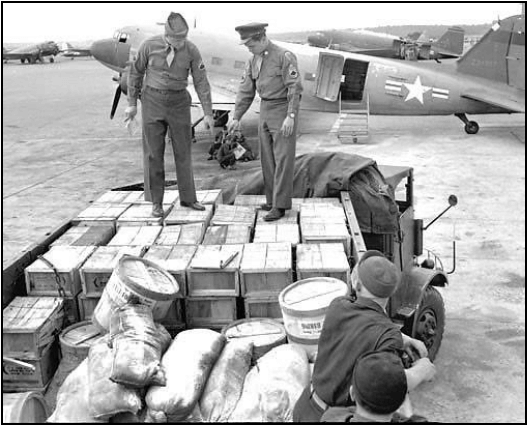
[From https://schoolshistory.org.uk/topics/world-history/cold-war-1945-1972/berlin-airlift/. Accessed on 05 January 2021.]
QUESTION 2: WHY DID ANGOLA BECOME THE FOCAL POINT OF THE COLD WAR IN AFRICA IN THE 1970s?
SOURCE 2A
This source focuses on the origins of the Angolan War of Independence.
Rich in diamonds and oil, Angola was one of the last African nations to receive independence from a European power. On 25 April 1974, a Portuguese military coup d’état protesting the country’s colonial practices successfully overthrew the regime. The combined forces of the Popular Movement for the Liberation of Angola (MPLA), the National Front for the liberation of Angola (FNLA), and the National Union for Total Independence of Angola (UNITA) created a transitional government with the Alvor Accord of 1974. [From www.blackpast.org>angolan-civil-war1975-2002. Accessed on 7 February 2021.] |
SOURCE 2B
This source below explains the involvement of the superpowers in the Angolan Civil war of 1975.
The crisis in Angola developed into a Cold War battleground as the superpowers and their allies delivered military assistance to their preferred clients. The United States supplied aid and training for both the FNLA and UNITA, while troops from Zaire assisted Holden Roberto and his fighters. China, also, sent military instructors to train the FNLA. The Soviet Union provided military training and equipment for the MPLA. During the summer of 1975, the Soviet-supported MPLA was able to consolidate (establish) power in Luanda and oust (overthrow) the USA-supported FNLA from the capital, but the FNLA continued to attack. The remaining Portuguese troops failed to stem (stop) the violence. When MPLA leader Agostino Neto announced 11 November 1975 as the day of Angolan independence, Lisbon decided to withdraw its troops on that day. [From https://history.state.gov/milestones/1969-1976/angola. Accessed on 8 February 2021.] |
SOURCE 2C
The source below explains the reasons for South Africa’s involvement in the Angolan Civil War of 1975.
In the House of Assembly in January 1976 Vorster (South African Prime Minister) placed the blame for South Africa’s intervention in Angola squarely on the shoulders of the Russians and Cubans: ꞌOur involvement was the effect of Russian and Cuban intervention. If they did not enter Angola, if they did not take part in this affair, if they did not try to subvert (undermine) the whole of Angola and to suppress (contain) its people, South Africa would never have entered Angola at all … We went in to chase Cuba and the MPLA away from the dams (Ruacana and Calueque)’. [From South Africa in the 20th Century by BJ Liebenberg and SB Spies] |
SOURCE 2D
The photograph below appeared in The Observation Post and is titled ‘The enemy of my enemy is my friend.’ It depicts Magnus Malan, PW Botha and Jonas Savimbi on the Angolan border during the Angolan Civil War of 1975.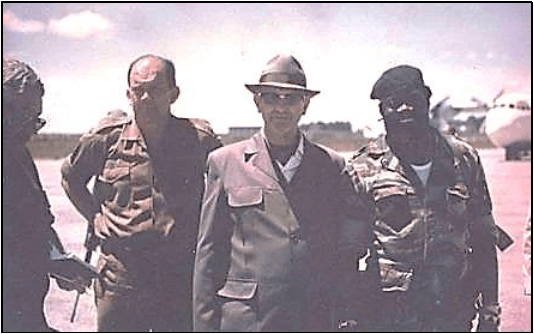
[From https://samilhistory.com/2017/08/19/the-enemy-of-my-enemy-is-my-friend/#comments. Accessed on 12 July 2021.]
QUESTION 3:
WHAT CHALLENGES DID THE LITTLE ROCK NINE FACE DURING THE INTEGRATION OF CENTRAL HIGH SCHOOL IN 1957?
SOURCE 3A
This source outlines the reason for the integration of educational facilities in Arkansas in the 1950s.
On 17 May 1954, the US Supreme Court ruled unanimously in Brown vs Board of Education of Topeka that racial segregation in educational facilities was unconstitutional. Five days later, the Little Rock School Board issued a statement saying it would comply with the decision when the Supreme Court outlined the method and time frame in which desegregation should be implemented. [From www.history.com>central high. Accessed on 8 February 2021.] |
SOURCE 3B
This source focuses on Elizabeth Eckford’s experiences on 4 September 1957, her first day at Central High School.
The first scene Eckford saw when she got off the bus a block from Central High School was a sea of angry faces. She tried to walk to school, but a jeering (taunting) mob blocked her path. All alone, her knees shaking, she pushed through the mob. She was trying hard not to show her fright. ‘It was the longest block I ever walked in my whole life’ she said later. Eckford was one of nine students who had volunteered to be among the first African Americans to attend Central High School. When she left for school that morning, Eckford thought there might be trouble. But she didn’t know that she would see hundreds of angry white people who had been waiting for her since early morning. Suddenly a shout went through the crowd. Elizabeth Eckford was attempting to enter the school. [From http://www.ahsd.org/ socialstudies/williamsm/The%20Mob%20at%20Central%20 High%20School.pdf. Accessed on 9 February 2016.] |
SOURCE 3C
The photograph below shows Elizabeth Eckford, one of the nine black students on her way to enroll at the all-whites Central High School, in Little Rock, Arkansas in August 1957. Behind her is a group of parents and members of the National Guard who were racially harassing her.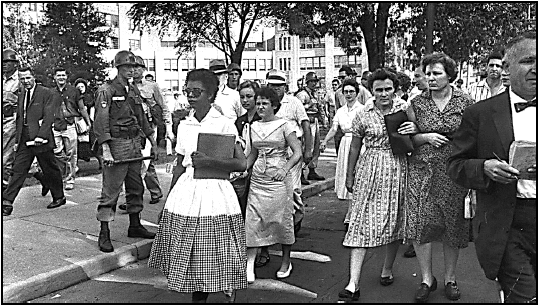
[From https://www.history.com/this-day-in-history/central -high-school-integrated. Accessed on 10 February 2021.]
SOURCE 3D
This source focuses on the events that occurred after the Little Rock Nine had started attending at Central High School in 1957.
That evening, from the White House, the president delivered a nationally televised address in which he explained that he had taken the action to defend the rule of law and prevent ‘mob rule’ and ‘anarchy’. On 25 September 1957, the Little Rock Nine entered the school under heavily armed guard. [From www.history.com>central-high... Accessed on 8 February 2021.] |
ACKNOWLEDGEMENTS
Visual sources and other historical evidence were taken from the following:
- A History of the United States, Volume II:1865 to the Present – American Voices by S Foresman
- historytoday.com
- http://www.ahsd.org/socialstudies/williamsm/The%20Mob%20at%20Central%20High%2 0School.pdf
- images.app.goo.gl/e27YpuvQ5ar9M6
- www.atomicheritage.org>history
- www.blackpast.org>angolan-civil-war1975-2002
- www.history.com/this-day-in-history/central -high-school-integrated
- www.history.com/topics/cold-war/berlin-blockade.
- www.history.com>central
- www.history.com>central-high…
- https://samilhistory.com/2017/08/19/the-enemy-of-my-enemy-is-my-friend/#comments
- South Africa in the 20th Century by BJ Liebenberg and SB Spies
History Paper 1 Questions - Grade 12 September 2021 Preparatory Exams
INSTRUCTIONS AND INFORMATION
- This question paper consists of SECTION A and SECTION B based on the prescribed content framework in the CAPS document.
SECTION A: SOURCE-BASED QUESTIONS
QUESTION 1: THE COLD WAR: THE ORIGINS OF THE COLD WAR
QUESTION 2: INDEPENDENT AFRICA: CASE STUDY – ANGOLA
QUESTION 3: CIVIL SOCIETY PROTESTS FROM THE 1950s TO THE 1970s: THE CIVIL RIGHTS MOVEMENT
SECTION B: ESSAY QUESTIONS
QUESTION 4: EXTENSION OF THE COLD WAR: CASE STUDY – VIETNAM
QUESTION 5: INDEPENDENT AFRICA: CHALLENGES FACED BY THE CONGO AFTER INDEPENCE
QUESTION 6: CIVIL SOCIETY PROTESTS FROM THE 1950s TO THE 1970s: THE BLACK POWER MOVEMENT - SECTION A consists of THREE source-based questions. Source material that is required to answer these questions can be found in the ADDENDUM.
- SECTION B consists of THREE essay questions.
- Answer THREE questions as follows:
4.1 At least ONE must be a source-based question and at least ONE must be an essay question.
4.2 The THIRD question may be either a source-based question or an essay question. - You are advised to spend at least ONE hour per question.
- When answering the questions, you should apply your knowledge, skills and insight.
- You will be disadvantaged by merely rewriting the sources as answers.
- Number the answers correctly according to the numbering system used in this question paper.
- Write neatly and legibly.
QUESTIONS
SECTION A: SOURCE-BASED QUESTIONS
Answer at least ONE question, but not more than TWO questions, in this section. Source material that is required to answer these questions is contained in the ADDENDUM.
QUESTION 1: HOW DID THE BERLIN BLOCKADE CONTRIBUTE TO COLD WAR TENSIONS BETWEEN THE UNITED STATES OF AMERICA (USA) AND THE SOVIET UNION (USSR)?
Study Sources 1A, 1B, 1C and 1D and answer the questions that follow.
1.1 Refer to Source 1A.
1.1.1 Which country, according to the source, was divided after the Second World War? (1 x 1) (1)
1.1.2 List the TWO decisions from the source that was taken at the Potsdam Conference. (2 x 1) (2)
1.1.3 How, according to the source, did Stalin want to punish Germany economically? (1 x 1) (1)
1.1.4 Explain why you think Stalin saw the introduction of a new currency by Western powers as a violation of their post-war agreements. (1 x 2) (2)
1.1.5 How, according to the source, did Stalin react towards the introduction of a new currency in West Berlin? (2 x 1) (2)
1.2 Read Source 1B.
1.2.1 Define the concept Cold War in your own words. (1 x 2) (2)
1.2.2 Why do you think the Allies were not prepared to risk an armed conflict with the Soviets? (2 x 2) (4)
1.2.3 Define the concept capitalism in the context of the Cold War. (1 x 2) (2)
1.2.4 Why, according to the source, was Stalin not prepared to use force against the Western Allies? (1 x 1) (1)
1.2.5 Name any TWO countries from the source that formed the German Federal Republic. (2 x 1) (2)
1.2.6 Comment on what is implied by the statement, ‘The allies were now determined to build up West Berlin as showcase for capitalism’. (1 x 2) (2)
1.3 Consult Source 1C.
1.3.1 List any TWO items from the source that the Allied Powers supplied West Berlin with. (2 x 1) (2)
1.3.2 Comment on the impact that the Berlin Blockade had on ordinary Berliners. (1 x 2) (2)
1.3.3 Using the information from the source and your own knowledge, explain why West Berliners did not accept food from Russia. (2 x 2) (4)
1.3.4 Explain the usefulness of this source to historians researching the impact of the Berlin Blockade on the Allied Powers and citizens of West Berlin. (2 x 2) (4)
1.4 Study Source 1D.
1.4.1 Explain the messages that are conveyed by the photograph. (2 x 2) (4)
1.4.2 What mode of transport was used by Western powers to transport food to West Belin? (1 x 1) (1)
1.5 Refer to Sources 1C and 1D. Explain how the information in Source 1C supports the evidence in Source 1D regarding the assistance that was given to West Berlin in 1948. (2 x 2) (4)
1.6 Using the information from the relevant sources and your own knowledge, write a paragraph of about EIGHT lines (about 80 words) explaining how the Berlin Blockade contributed to Cold War tensions between the United States of America and the Soviet Union. (8)
[50]
QUESTION 2: WHY DID ANGOLA BECOME THE FOCAL POINT OF THE COLD WAR IN AFRICA DURING THE 1970s?
Study Sources 2A, 2B, 2C and 2D and answer the following questions.
2.1 Refer to Source 2A.
2.1.1 List TWO natural resources in the source that made Angola susceptible (vulnerable) for foreign intervention. (2 x 1) (2)
2.1.2 Define the concept ‘ceasefire’ in your own words. (1 x 2) (2)
2.1.3 Which country, according to the source, colonised Angola before 1975? (1 x 1) (1)
2.1.4 Mention the THREE liberation movements in the source that created a transitional government to govern Angola in 1974. (3 x 1) (3)
2.1.5 Explain why you think Russia decided to support the MPLA during the Angolan Civil War of 1975. (2 x 2) (4)
2.2 Read Source 2B.
2.2.1 Why, according to the source, did the crisis in Angola develop into a Cold War battleground after independence? (1 x 2) (2)
2.2.2 Explain why you think the United States of America decided to support the FNLA and UNITA during the Angolan Civil War of 1975. (1 x 2) (2)
2.2.3 What is implied by the statement, ‘The MPLA also had long- established relations with Fidel Castro’s Cuba’? (1 x 2) (2)
2.2.4 Explain the term independence in the context of the Angolan Civil War of 1975. (1 x 2) (2)
2.3 Consult Source 2C.
2.3.1 Who, according to the source, did Vorster blame for South Africa’s intervention in Angola? (2 x 1) (2)
2.3.2 Name the TWO dams in the source that South Africa protected from the MPLA and Cuban intervention. (2 x 1) (2)
2.3.3 Using the information in the source and your own knowledge, explain why South Africa wanted to prevent a hostile MPLA government from taking control of Angola. (2 x 2) (4)
2.3.4 Explain the usefulness of this source for historians researching the reasons for South Africa’s involvement in the Angolan Civil War of 1975. (2 x 2) (4)
2.4 Study Source 2D.
2.4.1 Explain the messages the photographer wishes to convey about the relationship between South Africa and UNITA. (2 x 2) (4)
2.4.2 Explain what you think is implied by the statement, ‘The enemy of my enemy is my friend’. (1 x 2) (2)
2.5 Refer to Source 2C and 2D. Explain how the information in Source 2C supports the evidence in Source 2D regarding South Africa’s involvement in the Angolan Civil War of 1975. (2 x 2) (4)
2.6 Using the information from the relevant sources and your own knowledge, write a paragraph of about EIGHT lines (about 80 words) explaining why Angola became the focal point of the Cold War in Africa during the 1970s. (8)
[50]
QUESTION 3: WHAT CHALLENGES DID THE LITTLE ROCK NINE FACE DURING THE INTEGRATION OF CENTRAL HIGH SCHOOL IN 1957?
Study Sources 3A, 3B, 3C and 3D and answer the following questions.
3.1 Refer to Source 3A.
3.1.1 What, according to the source, was the ruling of the USA Supreme Court in the Brown vs the Board of Education of Topeka case? (1 x 2) (2)
3.1.2 Define the term desegregation in your own words. (1 x 2) (2)
3.1.3 What is implied by the statement, ‘racial segregation in educational facilities was unconstitutional’? (1 x 2) (2)
3.1.4 How many students, according to the source, showed interest in attending Central High School in 1957? (1 x 1) (1)
3.1.5 Explain why you think the eight Black students decided to remain at the all-black Horace Mann High School. (1 x 2) (2)
3.2 Use Source 3B.
3.2.1 What evidence in the source suggest that Elizabeth Eckford was nervous upon her arrival on her first day at Central High School? (1 x 2) (2)
3.2.2 Quote THREE pieces of evidence in the source that suggest that Elizabeth Eckford’s life was in danger. (3 x 1) (3)
3.2.3 Comment on the attitude of the white mob towards the integration of education at Little Rock High School. (2 x 2) (4)
3.2.4 What conclusions can be drawn from Grace Lorch’s attitude towards Elizabeth Eckford? (2 x 2) (4)
3.3 Consult Source 3C.
3.3.1 What messages does the photograph convey regarding racial integration at Little Rock High School? Use visual clues in the source to support your answers. (2 x 2) (4)
3.3.2 Explain the reliability of this source for historian researching the Little Rock Nine incident in 1957. (2 x 2) (4)
3.4 Study Sources 3B and 3C. Explain how the information in Source 3B supports the evidence in Source 3C regarding the treatment of Elizabeth at Central High School. (2 x 2) (4)
3.5 Read Source 3D.
3.5.1 List TWO reasons from the source that forced the president to take action during the Little Rock incident. (2 x 1) (2)
3.5.2 Provide TWO examples from the source that shows that the nine students did not have a pleasant experience during their first year at Central High School in 1957. (2 x 1) (2)
3.5.3 Why do you think Governor Faubus ordered the three high schools in Little Rock to close? (1 x 2) (2)
3.5.4 Explain the concept integration in the context of the Civil Rights Movement in the USA. (1 x 2) (2)
3.6 Using the information from the relevant sources and your own knowledge, write a paragraph of about EIGHT lines (about 80 words) explaining the challenges that the Little Rock Nine faced during the integration of Central High School in 1957. (8)
[50]
SECTION B: ESSAY QUESTIONS
Answer at least ONE question, but not more than TWO questions, in this section.
Your essay should be about THREE pages long.
QUESTION 4: EXTENSION OF THE COLD WAR: CASE STUDY – VIETNAM
‘Operation Rolling Thunder’ was the only strategy that the United States of America used in the Vietnam war to contain communism. Do you agree with this statement? Use relevant evidence to support your line of argument. [50]
QUESTION 5: INDEPENDENT AFRICA: CHALLEGES FACED BY THE CONGO AFTER INDEPENDENCE
Critically discuss the political and economic challenges that the Congo faced after attaining independence from Belgium in 1961. Use relevant examples to support your answer. [50]
QUESTION 6: CIVIL SOCIETY PROTESTS FROM THE 1950s TO THE 1970s: THE BLACK POWER MOVEMENT
Explain to what extent the Black Power Movement was successful in changing the lives of African Americans in the USA in the 1960s. [50]
TOTAL: 150
Geography Paper 2 Annexure - Grade 12 September 2021 Preparatory Exams
ANNEXURE
FIGURE 1.3: RURAL SETTLEMENT ISSUE RELATED TO RURAL DEPOPULATION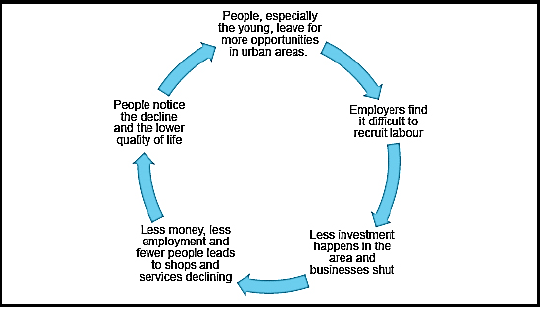
[Source: https://www.google.com]
FIGURE 1.4: URBAN LAND-USE ZONE ̶ CBD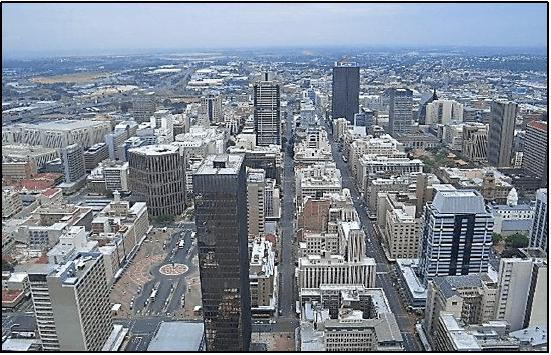
[Source: https://www.bing.com]
FIGURE 1.5: URBAN ISSUE RELATED TO SERVICE PROVISION (BASIC SERVICES)
ILLEGAL CONNECTIONS: 211 JOBURG INFORMAL SETTLEMENTS ACCUSED OF STEALING CITY POWER'S ELECTRICITY About 211 informal settlements in the City of Johannesburg have been accused of stealing City Power's electricity. City Power said it was losing billions of rands in revenue. City Power spokesperson Isaac Mangena said a total of five lives had been lost due to electrocution. On Wednesday, City Power pounced on the informal settlement and removed illegal connections. Mangena said they were in the area conducting cut-offs for the second time in less than a month. “We won’t get tired to return and cut off their illegal electricity, because they are costly not only to us, but to infrastructure. We have witnessed many of our substations exploding because of overloading caused by illegal connections.” “Whenever, there is an outage caused by an explosion, legal consumers are the ones suffering, including those working from home. They might lose their jobs due to rampant outages caused by overloading,” Mangena said. Mangena advised residents to petition government in order to have legal electricity installed. “We have about half a million households that we provide legally with electricity. We also have 211 informal settlements with an estimation of about 5 000 households that are illegally connected. We think that the number of illegal connections could be more.” [Adapted from News24, 9 March 2021] |
FIGURE 2.2: ECONOMIC SECTORS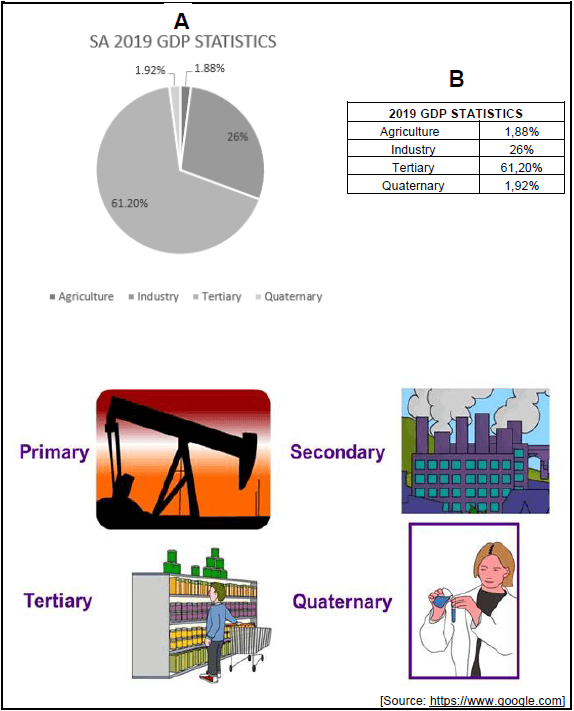
FIGURE 2.3: PRIMARY ECONOMIC ACTIVITY – COAL MINING
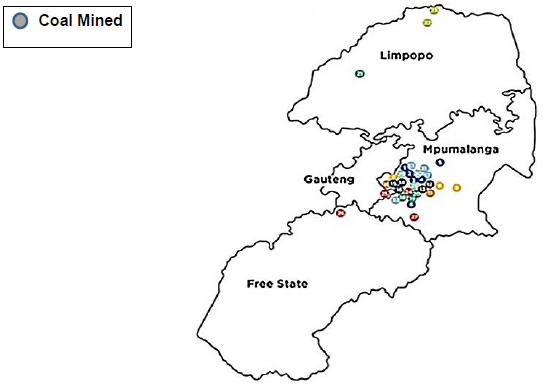 |
A photograph in the entrance hall at Komati Power Station shows the plant in better times, its nine generating units belching steam and smoke into the night sky. [Source: https://www.engineeringnews.co.za] |
FIGURE 2.4: STRATEGIES FOR INDUSTRIAL DEVELOPMENT – THE SALDANHA BAY INDUSTRIAL DEVELOPMENT ZONE (SBIDZ)
[Source: Google Images – Saldanha Bay Industrial Development Zone] SALDANHA BAY INDUSTRIAL DEVELOPMENT ZONE ATTRACTS INVESTMENTS February 28, 2021 The Saldanha Bay Industrial Development Zone has to date attracted over R21 billion worth of investments, says Trade, Industry and Competition Deputy Minister Fikile Majola. [Source: Researchgate.net] |
FIGURE 2.5: TERTIARY SECTOR – INTERNATIONAL TRADE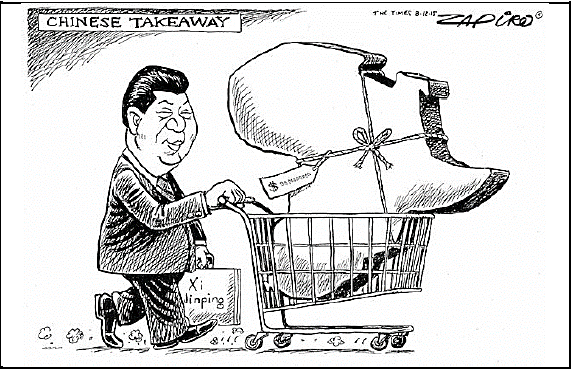
[Source: Daily Maverick, 17/02/202]
SECTION B: GENERAL INFORMATION ON LOUIS TRICHARDT
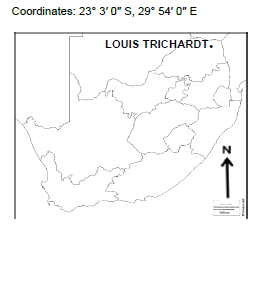 |
| Louis Trichardt is a town at the foot of Songozwi, in the Soutpansberg mountain range in the Limpopo province of South Africa. It is the centre of the Makhado Local Municipality, and is located in a fertile region where litchis, bananas, mangoes and nuts are produced. The N1 National Route runs through the town. Louis Trichardt is 437 kilometres from Johannesburg and one hour's drive from the Zimbabwean border at Beitbridge. Most of Louis Trichardt's economy is boosted by farming activities around the town. The town's economy might experience a further boost if proposed mines open in the area. There has, however, been a lot of resistance from nature conservationists against mines opening in the area. |
FIGURE 3.9: BUFFER ALONG DORP RIVER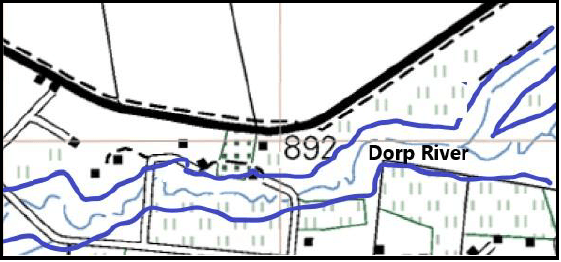
[Source: Examiner]
